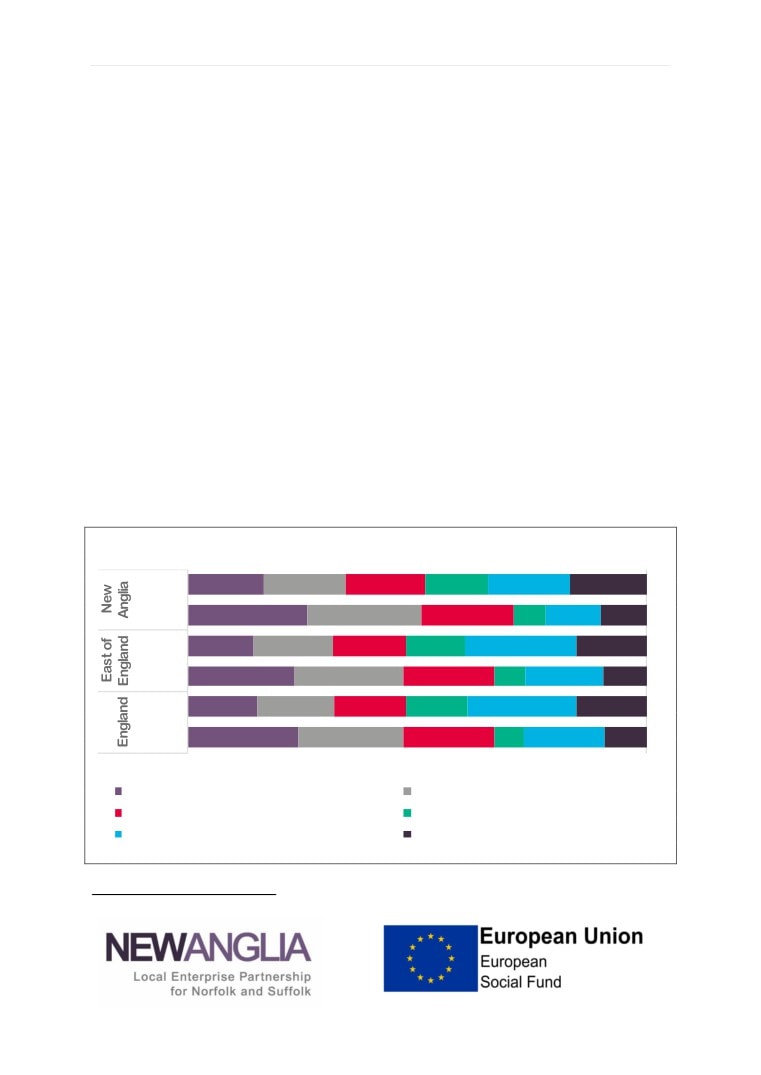Enabling Growth in the
New Anglia Advanced
Manufacturing &
Engineering Sector
through Skills
Development
2018-‘25
New Anglia LEP Sector Skills Plan - Advanced
Manufacturing & Engineering
January 2018
1 | P a g e
Contents
Background Context
2
Executive Summary
3
Overview of the Advanced Manufacturing and Engineering Sector
4
Sector Definition
6
Skills & Workforce Supply
7
Opportunities and Challenges
10
The AME Sector Skills Plan
19
Priorities for Action
19
Need for a Step Change
20
AME Sector Skills Plan Delivery
21
Proposed Skills Interventions
23
Appendix A - Sector Skills Plan Development Process
28
Consultees
29
Appendix B - Summary of DataPack & Other Sector Intelligence
31
Links to Other Sector Skills Plans
35
Appendix C - Current Skills and Training Provision for AME
37
Task and Finish Groups
44
Annex 1 - East of England Science and Innovation Audit (SIA) Extract adapted from the
Summary Document:
50
2 | P a g e
Background Context
The Advanced Manufacturing and Engineering (AME) Sector Skills Plan has been
developed by the AME sector in Norfolk and Suffolk, working alongside the New Anglia
Local Enterprise Partnership, the New Anglia Skills Board and supported by SkillsReach.
SkillsReach was contracted to facilitate and prepare eight sector skills plans for the New
Anglia LEP priority sectors. The project was commissioned by the Education and Skills
Funding Agency, in partnership with New Anglia LEP, and funded through the European
Social Fund. Each Sector Skills plan and supporting Data Pack has been developed in
collaboration with local employers and other stakeholders.
The Advanced Manufacturing and Engineering Sector Skills Plan has been developed in
partnership with the New Anglia Advanced Manufacturing and Engineering (NAAME) sector
group, the lead organisation taking forward the further development and implementation of
this plan in conjunction with New Anglia LEP, local education institutions and other
stakeholders and key sector champions.
The New Anglia Skills Board places employers at the centre of decision making on skills in
Norfolk and Suffolk to ensure the skills system becomes more responsive to the needs of
employers, and the future economy.
NAAME’s Sector Growth Strategy1 (2017) focused on six areas to drive sector growth:
Financially backing the sectors as drivers of economic growth;
Embed supply chains and knowledge locally;
Bring together businesses in special interest groups;
Improve the infrastructure across Norfolk and Suffolk;
Increase the engagement between schools and businesses;
Focus on New Anglia’s emerging sub-sectors.
SkillsReach is an established East of England-based strategic skills consultancy with an
associate project team with extensive experience of developing skills plans.
1 Hethel Innovation, NAAME Sector Group (2017), Norfolk and Suffolk Sector Growth Strategy: Advanced
Manufacturing and Engineering
3 | P a g e
Executive Summary
Advanced Manufacturing and Engineering (AME) is a large and dynamic sector in the New
Anglia economy and one that the area wishes to prioritise given the high skilled, high wage
profile of the sector.
The sector is, however, facing significant challenges in meeting its future workforce and
skills needs and expected changes in the industry are likely to exacerbate this challenge.
Notably the engineering and manufacturing sectors are on the cusp of widespread adoption
of new technology, often called Industry 4.0 or the 4th Industrial Revolution, through which
traditional engineering is becoming intimately entwined with sensors, automation and ICT.
These changes in the context for the industry are an enormous opportunity and one which
we know will change the skills we need, probably ultimately in ways we have not yet even
considered. As with earlier industrial revolutions the prize is economic growth, better and
safer working conditions and enhanced life opportunities, but Norfolk and Suffolk are not
alone in the race to adopt this new technology.
The skills that our existing workforce have and continue to develop will help us lead this
process of change, but we also need to attract many more young people by helping to
describe clearly how a career in our industry is dynamic and has real prospects. If we are
right about Industry 4.0 these prospects will not only be in the traditional AME sector, the
skills we have in manufacturing and engineering will also be enablers of change right across
the economy, from health care to transport to food production and science.
We propose to work on four supplementary areas to support the focus on Industry 4.0:
Careers of the Future to ensure the sector projects its career opportunities effectively;
Developing AME Course Provision to ensure courses meet changing employer needs;
Physical Facility Development to ensure we increase the capacity for training;
Tutor Development to increase the supply of tutors to train more people in AME skills.
Every sector will need our support to embrace the opportunities automation and ICT can
bring and will need to draw on skills in advanced manufacturing and engineering. The task
before us is therefore a once in a generation opportunity to rethink our skills system, with
employers working with education and skills providers to rise to the opportunity.
The New Anglia Advanced Manufacturing and Engineering (NAAME) sector group is
pleased to be helping to drive this agenda and look forward to working with you so that
together we can meet the future skills needs of the industry.
NAAME sector group, January 2018
Acknowledgements
The New Anglia LEP wish to thank the employers, providers and stakeholders who
contributed to the plan by attending events, being interviewed or by making referrals to
employers and organisations in the sector. The sector skills plan was developed in 2017/18
by SkillsReach.
4 | P a g e
Overview of the Advanced Manufacturing and Engineering Sector
In total the Advanced Manufacturing and Engineering (AME) sector currently employs
84,500 people in the New Anglia area, approximately 11% of the workforce. Employment in
the sector has fallen by three per cent since 2010 (-3,100 jobs).
The inclusion of food manufacturing within the defined sector means that the sub sectors of
‘Processing and preserving of poultry meat’ and ‘Production of meat and poultry meat
products’ are the first and third largest with 4,600 and 3,200 workers respectively2. In second
place is the sub sector ‘Other engineering activities’ with 4,500 workers.
In terms of Gross Value Added (GVA) the sector in 2015 was worth approximately £5.1bn to
the LEP area, which equates to just over 14% of the total New Anglia economy. This is an
increase of £745m on 2010 (+17%) but does mask a drop in GVA between 2014 and 2015
of just over £60m.
The higher share of GVA (14%) compared to workforce (11%) shows that the sector has a
higher per capita GVA than the economy as a whole, which given full or very close to full
employment in the LEP areas suggests that a focus on growing this sector would allow the
economy to expand even without additional net employees in the LEP area. The GVA per
capita employed is £60,355.
In 2016 there were 6,040 AME enterprises operating in the New Anglia area, or 10% of all
enterprises. Since 2010 the number of Advanced Manufacturing and Engineering
enterprises has increased by 425, or around 8%, which is below the total New Anglia rate of
growth for enterprises of just over 9%.
Given the smaller share of enterprises (10%) than share of the workforce (11%) or
contribution to GVA (14%), the data suggests that enterprises in the sector are both larger
and more productive than the average for all enterprises in the LEP area.
The growth in New Anglia AME sector GVA since 2010 is higher than national and regional
averages of +15%, higher than Greater Lincolnshire LEP (+1%) and South East LEP (-2%),
but below Greater Cambridge & Greater Peterborough LEP (+27%).
Nationally, employment in the sector grew 3%, whilst South East LEP has seen a decrease
of -6% since 2010. Greater Cambridge and Greater Peterborough LEP AME employment
increased in line with nationally trends and Greater Lincolnshire had an increase of +10%.
The Suffolk Limited report (2017)3 includes 10 manufacturing businesses in its top 100
Suffolk companies employing 2,000 staff (excluding the largest employers such as Greene
King). These companies showed a year on year growth of +24% for turnover and +53% for
operating profit, showing that this mid-tier of medium and larger companies are seeing
strong growth, with this sector growing faster than the average for all companies in Suffolk.
2 The food processing sector was covered in more depth in the New Anglia AgriFood Tech Sector Skills Plan
developed by the LEP in 2017
3 Grant Thornton, Birketts (2017), Suffolk Limited 2017: Growth in Interesting Times
5 | P a g e
The AME industry is diverse and includes technology providers, underpinning R&D centres
and innovative companies, but in addition many specialist engineers and manufacturing
trained staff are employed directly in businesses which make, service or install a wide range
of other products or services. The manufacturing sector is increasingly high tech and across
many industries advanced manufacturing principles are now being applied, including in:
Automotive, trailers and vehicles
Boatbuilding
Aerospace
Bio-economy
Robotics, automation, ICT equipment
Health equipment
Chemicals
Construction
Energy, oil and gas
Offshore and marine
Agrifood automation (Norfolk and Suffolk
SME base strong)
Engineering is both a sector in its own right and a source of skills for many other companies
in virtually every sector given the pervasive use of engineering in virtually every workplace.
Defining the Scope
The adopted scope is:
Engineering companies
Manufacturing companies
Technology suppliers
R&D centres and providers
Engineering and manufacturing consultants Training providers
Many larger manufacturers and service sector companies also have in house engineering
capability e.g. most food companies have an in house engineering team as well as
employing external contractors, the same is true in logistics and other similar sectors.
Over 30% of the top 100 companies (by sales) in Norfolk and Suffolk4 are in the
manufacturing and engineering sector, with over 60% of the total turnover being in food
manufacturing. This focus on larger employers also means the sector is likely to be a major
contributor to the Apprenticeship Levy with work by SkillsReach (2017) suggesting that 21%
of the levy in New Anglia, circa £10.5m, will be paid by advanced manufacturing with a
further 24% in the agrifood tech sector (£12m), much of which relates to larger food
manufacturing companies.
As well as larger employers the AME sector includes a large number of SMEs as
manufacturers or as service providers.
Future Growth potential
Major developments in the industry in New Anglia will drive local growth, including notably:
The continued growth of Hethel Innovation (including Lotus cars - recently acquired by
Geely the Chinese owner of Volvo and associated companies);
4 EDP and EADT (2017), top 100 companies
6 | P a g e
The development of the A11 technology corridor to Cambridge focused on the AME
sector is a core part of the economic development agenda for the Councils on the route;
The Norwich Aviation Academy;
Investment by the MOD in new engineering capacity, for example the confirmation of
RAF Marham as a long term strategic base for strike aircraft including its Engineering &
Logistics Wing (ELW);
The potential development of Sizewell C in Suffolk could lead to further substantial
growth of the sector in the New Anglia area in the medium to long term.
The energy, logistics and construction sectors are also witnessing steady growth, much of
which is increasingly using AME technologies and expertise.
The perception of consultees was that the sector is currently seeing slow but steady growth
with new regulations, market needs or technology driving a need to upgrade existing
equipment e.g. new refrigeration regulations in 2020.
In other parts of the industry the use of new machines, such as CNC lathes, which typically
cost £200-400,000 and require high levels of ICT skills as well as engineering skills, will
continue to change the sector and lead to higher productivity and growth. However,
consultees were concerned that the UK is ‘behind the curve’ and has been slow to adopt
these types of new systems and equipment compared to other countries.
Sector Definition
The sector definition applied to the recent New Anglia LEP Economic Strategy Evidence
Base, and reproduced here, encompasses all manufacturing activity in the area, as opposed
to highlighting only the ‘advanced’ elements and engineering. The rationale, endorsed by
consultees is that all manufacturing now has to be ‘advanced’ if it is to be competitive5.
This wide definition means that there are sizeable overlaps between the AME sector and
AgriFood Tech (food and drink manufacturing), Digital Tech (printing and publishing), Life
Sciences & The Bio-Economy (Manufacture of pharmaceuticals; precision instruments),
Transport & Logistics (Repair and maintenance of lorries, ships, aircraft etc.), and Tourism &
Culture (Manufacture of Jewellery, musical instruments, games etc.).
To help identify the breadth of the sector, its major sub-sectors and constituent companies,
Hethel Innovation (2017) has developed sector reports for High Value Manufacturing and
Engineering6 which show how vibrant and diverse the AME sector is in New Anglia. These
reports will support sector growth and networking programmes run by NAAME.
5 The only exception would be the limited niche market for handmade, traditional products which make a
virtue and marketing proposition from not using modern automated or highly technical production methods.
Whilst there is a growing market for these speciality products, consultees felt that they would remain a niche
market with a low overall percentage market share
6 Hethel Innovation (2017), Network Development Reports for High Value Manufacturing and Advanced
Engineering: precision engineering; automotive sector; advanced materials - composites; electronics sector
7 | P a g e
Skills & Workforce Supply
Analysis of LEP level results for the ‘Manufacturing’ sector from the UKCES Employer Skills
Survey 2015 shows that the ‘Manufacturing’ sector was more likely to report skills shortage
vacancies (28%) as a proportion of all vacancies than both the New Anglia all sector (19%)
and national (23%) averages. Evidence suggests that, as consultees reported, productivity
is improving but there is uncertainty about future workforce size.
In total, 6,820 learning aims related to the AME sector were delivered to New Anglia
residents in 2012/13, 8.5% of all learning aims delivered in New Anglia, compared to 5.8%
for the AME sector nationally. Since 2010/11, there has been an 18% increase in the
number of AME learning aims delivered to New Anglia residents. This contrasts with a
national decrease of 3%, which suggests that the sector locally is bucking the national trend
and trying to ensure that future workforce skills needs are met.
Analysis of data sourced from the Department for Education’s Further Education data library
based on the Sector Lead Bodies identified as being the most relevant to the AME sector:
Process Manufacturing; and Science, Engineering & Manufacturing, shows that the majority
of these learning aims (5,360 or 79%) achieved by New Anglia residents were delivered by
New Anglia based providers. This is slightly more than the average for New Anglia across all
sectors (75%) suggesting the sector is relatively well supported by local skills providers.
Provision of Advanced Manufacturing & Engineering learning aims by New Anglia providers
to New Anglia residents has increased, with growth strongest in ‘Process & Manufacturing’
at +54%, though the majority of learning aims are still delivered under ‘Science, Engineering
& Manufacturing Technologies’ with 3,110 registrations.
In 2015/16 there were 1,810 starts in ‘Engineering and Manufacturing Technologies’
apprenticeships in New Anglia, 13% of all apprenticeship starts in the area. Growth over time
in ‘Engineering and Manufacturing Technologies’ apprenticeship starts is below that of
regional and national comparators, and that of growth in the number of apprenticeship starts
overall. Data on apprenticeship participation by sector provides a slightly different
perspective with the Manufacturing sector accounting for 8.4% (2,580) of all apprenticeships
in 2014/15, which is lower than the level of employment in the sector at 11%.
Despite recent growth in participation rates locally, 22% of manufacturing employers in New
Anglia reported having staff that were not fully proficient in 2015, compared to an average of
14% nationally, suggesting that further growth in investment in staff training is needed. This
is confirmed by the fact that staff not fully proficient as a percentage of employment in the
sector was 5%, above the New Anglia average of 3% but in line with regional and national
rates. The data points to staff not being fully proficient as an issue particularly for smaller
employers.
UKCES data and the East of England Forecasting Model suggest that the sector is projected
to decline in employment between 2014 and 2024 by circa 10% (approximately 8,000 jobs).
However, this projected decline is not reflected by local employers who, subject to continued
favourable business conditions and workforce supply, expected slow but steady growth.
8 | P a g e
Even if the sector does see an overall decline in employment, there will still be growth areas
within the sector with around 7,000 new jobs forecast over this period. In addition,
replacement demand is expected to be somewhere in the region of 30,000 jobs.
This suggests a net requirement for new staff in the sector at 37,000 over the decade from
2014-2024. New jobs creation (expansion demand) will be primarily in roles requiring
degree level skills and higher (Level 4 and above) with job losses in lower skilled roles.
Despite the overall projected decline in job numbers there will still be growth areas within the
sector with around 7,000 new jobs at Level 4 to 6 (HE to First degree level) and above
(figure 1) and a projected small increase in the number of post graduate level roles, with in
total over 7,500 additional jobs created in the AME sector for those with L4+ qualifications.
In contrast at L3 and below the number of employees is projected to fall, with an overall fall
of over 15,000 job roles at this level. This is consistent with feedback from consultees, who
universally predicted a continued need to upskill the workforce as new technology drives the
sector forward.
At the same time, there will be a significant number of existing jobs to replace as people
leave the sector workforce. The replacement demand at both ends of the skills range, for
those staff with no qualifications/level 1 and at the other end levels 7-8 are very modest.
Most replacement demand is focused on levels 2-6, with the demand for L2, L3 and L4-6 all
fairly even.
Fig 1 Projected future skills demand by level for New Anglia AME sector
-5,000
-2,500
0
2,500
5,000
7,500
10,000
12,500
15,000
QCF 7-8
QCF 4-6
QCF 3
QCF 2
QCF 1
No Qual
Expansion Demand
Replacement Demand
9 | P a g e
Advanced Manufacturing & Engineering Skills Supply and Demand
As with the overall workforce in New Anglia, the AME workforce is becoming more highly
skilled as analysis of 2001 and 2011 Census data shows (figure 2). However, in terms of the
shift in qualification levels, New Anglia still lags behind regional and national averages for
the AME sector. Nonetheless, the demand for L3 or L4+ skills increased from 19% to 32%
over the decade to 2011 and consultees reported that they believed it has continued to grow
since 2011 and will do so in future. This trend can be seen in changes in qualifications in the
sector between 2001 and 2011 (figure 2).
The trend in the qualifications profile in New Anglia (figure 2) shows that the industry has
been managing this change to higher qualifications for many years which should help to
meet the anticipated future demands (figure 1).
UKCES (2015)7 found that New Anglia manufacturers on average are marginally less likely
to have vacancies than local, regional and national averages. However, companies with
vacancies are much more likely to report these as being Skills Shortage Vacancies (SSVs).
The AME sector’s performance against training measures (such as the provision of training
in the last year, and on-the-job training) shows that it is either broadly in line or above local,
regional and national averages for all indicators compared to other sectors, apart from online
or e-learning training. Similarly, training days per trainee and trainee days per staff, are both
much higher than all comparators.
Manufacturing employers are also less likely to report underutilised staff than local, regional,
and national averages for all sectors, 21% compared to 25%, 25%, and 30% respectively.
Fig 2. Qualification profile in the AME sector
2011
16%
18%
17%
14%
18%
17%
2001
26%
25%
20%
7%
12%
10%
2011
14%
17%
16%
13%
24%
15%
2001
23%
24%
20%
7%
17%
9%
2011
15%
17%
16%
13%
24%
15%
2001
24%
23%
20%
7%
18%
9%
0%
100%
No qualifications
Level 1 qualifications
Level 2 qualifications
Level 3 qualifications
Level 4 qualifications and above
Apprenticeships and other qualifications
7 UKCES (2015), Employer Skills Survey 2015
10 | P a g e
Opportunities and Challenges
Employers and consultees identified a wide range of key workforce and skills challenges
which need to be addressed to facilitate future growth of the AME sector, including:
Workforce supply:
Recruitment of experienced staff (30+age group) is generally done through national
advertising using recruitment agents as there is a lack of local supply and this is not
expected to change as employers want to attract the best talent available nationally.
One specific challenge noted by employers was the hourglass age profile of the
workforce, with a noticeable gap in many companies workforce in mid career staff what
one consultee called a ‘missing generation’, and a problem despite a recent increase in
recruitment at younger ages that as the older workforce retires the next generation (30-
45 age group) who would be expected to replace them is missing.
Specialist CPD for the existing workforce is also a national market as there is not enough
local demand to offer courses in all areas given the multitude of different specialist skills
needed across the AME sector. The demand for CPD is expected to grow given the
speed of change in the industry and the technology the AME sector is using. Consultees
also reported a frustration that in their view there were no programmes in place for older
experienced people to retrain / gain skills to help fill the gaps in industry workforce
supply.
Some work e.g. engineering design work, is being contracted out of the region or UK to
access specialist skills available globally. This is the reality of modern global supply
chains and it is important for New Anglia to be clear on which parts of the industry to
focus local skills initiatives on as the area cannot lead on all areas and, as a
consequence, to accept that for some other skills it may be preferable to work with global
centres of expertise.
Many staff, estimated across the engineering sector at 10-11%, come from other EU
states and this is creating additional uncertainty for the future given the likely restrictions
employers expect after Brexit. Many agencies which help to fill short term gaps in
workforce supply have a much higher % of their workers drawn from overseas and in
2017 have started to struggle to meet company needs.
Current course provision:
Some sub-sectors within AME don’t have appropriate apprenticeship provision e.g.
ventilation engineering.
There is also a more general concern that the apprenticeship frameworks are very rigid,
overly prescriptive and don’t meet the needs of many companies in the sector.
Feedback shows that in this sector both providers and employers are frustrated by the
inability to flex course content to meet employer needs, with employers saying that this
means they are not able to use government endorsed training to meet their needs. They
believe that as the system changes to one in which employers are expected to pay more
of the cost of the training provided that this must change so that the customer receives
what they want to pay for.
Current FE course funding mechanisms are overly prescriptive and are stopping new full
time provision which responds to challenges such as Industry 4.0, because the current
funded frameworks don’t allow students to combine aspects of engineering, ICT and
11 | P a g e
electronics which are needed to meet this. This requires new standards and frameworks
which are aligned with emerging industry needs or the freedom locally to adapt a light
touch national framework to meet local employers’ needs.
Similar development needs to happen in specialist AME areas such as the Aviation
sector to ensure that courses at IAAN are fully compatible with both funding models and
industry needs. In most cases this challenge requires more flexible funding.
There is also a perception that education exit points don’t meet industry needs and
expectations, whether at school or University/College level. Key challenges exist in
relation to technical and employability skills of those entering the industry. Employers
reported that even graduates or post graduates need to be viewed as ‘trainees’ for 3-4
years when they arrive in a company, as in most cases they lack the practical and
commercial skills needed and are not ‘job ready’.
There is also a need for clearer pathways for engineering / manufacturing career
progression through vocational progression and from FE to HE, as well as academic
routes. Several employers and national representative bodies, however, view the
current apprenticeships as much weaker than traditional courses as they are shorter,
less comprehensive and thus don’t in their view equip students with the skills needed.
Employers who visit schools to ‘sell’ the apprenticeship offer also reported concerns that
they find most pupils and staff don’t see apprenticeships as the preferred route post
school and this makes it hard to attract the best young people.
Some businesses reported that they have moved provider (within the region mainly) due
to problems with the quality of provision and because they were sent students who did
not meet industry needs.
There is a need for both core generic skills and in company expertise (given the diversity
and very specialist nature of most companies in the AME sector), with employers
recognising that they have a key role to play in the more specific company focused skills,
but in many cases frustrated at the lack of generic skills amongst students and new
recruits. The generic skills which employers require include: control systems, digital,
programming, servos/motors, fluid dynamics, new materials, additive manufacturing,
energy efficiency, communications and STEM foundations. Engineers also need to
develop basic hand skills to use tools and to have dexterity.
Some employers also reported that they were so confused or concerned by the way the
apprenticeship was working that they had decided to ignore the (new) apprenticeship
system and to recruit their own apprentices, outside the system, and deliver their own
training without trying to secure funding through the levy.
Overall though employers still felt that the current focus on apprenticeships, whilst
welcome, had come too late and that it was now imperative for everyone in industry and
government to come together to recruit and train more apprentices. There was also
widespread support amongst consultees for the development of degree apprenticeships,
but a recognition that awareness amongst young people and their families was still too
low and many still viewed apprenticeships as of less value than the academic route of ‘A’
levels followed by a degree.
Concerns were also expressed by both individual employers and sector bodies that the
new apprenticeship funding model was not working very well. The main concerns are
that the restrictions within the system make it very hard to access the levy funds because
in many cases the standards are not ready, providers are not ready or employers are
having problems accessing the online system. As a result it was felt that many
12 | P a g e
employers had decided to shelve plans for apprentices until system challenges have
been resolved.
Employers are also concerned that the current set of apprenticeship frameworks still
have significant gaps and this leaves many employers unable to access appropriate
provision to meet their needs.
Industry and stakeholder views on the responsiveness of skills provision:
The ‘stop/start’ nature and complexity of skills funding and initiatives is a major problem
in retaining AME employer commitment and interest in skills programmes. More stability
and longer term commitment of government funding in the system would give employers
the confidence to invest alongside the public sector. Other employers pleaded for
government to ‘stop changing / messing around with what’s going on in schools, i.e. the
exam results are no longer A, B, C etc and are now 1, 2, 3 etc… nobody has informed
employers what the grade systems equate to so how on earth do we know.’
The ageing workforce and major new developments, such as the potential Sizewell C
plant, means that there are growing concerns about the security of future workforce
supply locally as new demands for staff and skills compete with existing employers.
The skills supply for some substantive sectors, e.g. polymers, is currently lacking and is
not addressing market needs (although there is some limited national provision, this is
not sufficient to support the sector’s growth potential).
Networking is poor both between education providers and business and between
businesses themselves in the AME sector. The business community needs to do more
to support each other and promote the sector as a career of choice.
The importance of 'REAL' Work Experience to inspire young people and its perceived
current dysfunctional nature from an employer perspective, means the sector is finding it
hard to attract the next generation it needs to support its growth aspirations.
There is lots of potential locally to address these concerns, with some innovative ideas
progressing such as Institute of Technology (IoT) and the Institute of Productivity, but
these need to ensure they are delivered in ways which are responsive to industry needs.
Interestingly though one consultee noted that there was also a problem with some
employers not releasing staff for training even when this was provided free by component
suppliers: ‘I am observing widely that (electronics) vendors can’t give away valuable
technical training in the UK. In Europe they can fill a classroom, in the Far East a lecture hall,
in the UK if they don’t cancel the event it is virtually a one to one session’.
College and University facilities and staffing:
There are recognised major challenges in relation to the level of skills and industry
awareness amongst teachers and lecturers given the speed of change in the industry
and the recognised challenges of recruiting teaching staff in AME disciplines.
More broadly there is a problem in recruiting the lecturers and teachers needed in
technical and engineering disciplines. The feedback from providers is that this problem
is becoming acute in some areas due to rising salaries in the commercial sector that
educational providers cannot compete with. There is also a recognition that this problem
may well be exacerbated by the need to deliver more higher level provision and to
embrace new topics, such as Industry 4.0, which require multi-skilled tutors who can
combine expertise in engineering with ICT.
13 | P a g e
Some employers find it hard to engage with Colleges as course planning is poor or late,
making it hard for employees and learners to fit the course around work. Others noted
that they now, for example for mechanical apprentices, use national EEF provision in
Birmingham due to a perception that local provision is of poorer quality. Other
employers noted that they were working with national providers e.g. Loughborough
University to develop chemical engineers due to lack of suitable local provision.
Employers recognised that Colleges faced problems accessing modern equipment for
training and a significant number said that they would be willing to work with providers to
address this challenge by sharing facilities. In a few cases this was seen as working well
e.g. International Aviation Academy Norwich, but there was a general feeling that this
could usefully be extended to other areas.
Specific areas with skills gaps identified by local employers included:
Electrical, instrumentation and control engineers where technicians are hard to find and
experienced engineers (graduate level) are very scarce leading to many companies
poaching from each other;
Mechanical engineers and mechanical engineering companies are both in short supply
so it is hard to obtain the skills needed even if you try to sub-contract the work;
Composites engineers are in short supply in a sub-sector with good growth potential and
a strong local sector in New Anglia;
Embedded software which enables small devices to support the Internet of Things (IoT)
by coding and communications via USB, Ethernet and radio - this requires a
combination of engineering and computing skills;
Chemical engineers and organic chemists, because whilst there are ‘lots of graduate
chemists available [there are] few with knowledge of organic chemistry synthesis’;
Ventilation systems, not least due to forthcoming regulatory changes which will increase
demand in this sector;
The rapid growth in additive manufacturing and 3D printing which will impact across all of
manufacturing and potentially in major new markets such as building.
Regional connectivity with neighbouring areas and national provision:
Consultees were keen to stress that the AME sector is not constrained by LEP
boundaries and many businesses and supplier/client relationships cross over LEP
boundaries.
Similarly staff and education provision crosses these boundaries, with notable AME
training providers in the West of the region, e.g. College of West Anglia and West Suffolk
College, having strong links into Cambridgeshire through their provision and student and
employer base. These linkages also include the need to link with national provision such
as the Institute for Manufacturing (IfM) and Welding Institute both of which are just
outside New Anglia.
In developing the New Anglia plan it is therefore important to ensure that opportunities to
collaborate with other areas are taken.
14 | P a g e
National and Regional Reports
The feedback from New Anglia employers and stakeholders is broadly consistent with
national and regional reports on the challenges and opportunities in the AME sector.
Notable recent national and international reports which deal with this sector include:
The Industrial Strategy (2017)8 sets out how the government see the UK economy
changing and how the UK needs to prepare itself for the future, not least due to the need to
make the UK more competitive to drive exports and trade post Brexit. There is a strong
focus on people within the strategy and the need to address perceived weaknesses in the
skills system to ensure that people are equipped with the skills needed to gain and retain
productive jobs which also help drive economic growth. As part of this it promotes
apprenticeships, investment in technical education and a major focus on STEM skills to
address the shortages of technical skills in AME and related sectors.
The Technology Industry Futures Report9 in spring 2017 was an update of the original
papers from 2010 and 2012 and was released on the same day as the Industrial Strategy
Green Paper. It received over 1,000 responses, held 7 round table consultations and
reviewed over 50 technologies and 100 articles. Its main conclusion was that the largest
change since 2012 was the convergence and interaction between different technologies into
new products and services which defy traditional sectoral boundaries. Amongst its
recommendations was a need for government to work with industry to act as a ‘skills planner
- prepare for growing demand for worker with multi-disciplinary technical skills, and mitigate
the impact of robots and machine learning replacing unskilled and graduate-level roles’.
The Made Smarter Review10 (developed as part of the Industrial Digitalisation Review) was
published in autumn 2017 and considered how digital technologies in all their forms (e.g.
robotics and automation, AI, VR etc.) will impact UK industry. It estimated that embracing
the transformative power of digitalisation has the potential to increase UK GVA by £455bn
(cumulative) over the next decade by improving productivity, reducing waste and developing
new markets. The review included a cross cutting theme of skills, which was a recurrent
theme in all the consultations held to produce the review. The parallel development (not yet
approved or published) of the Robotics and Autonomous Systems (RAS) sector deal
proposal has estimated that RAS could led to a long term increase in employment of 7% and
be worth an additional 15% of GVA or £218billion per annum.
The Impact of AI in UK Constituencies11 (2017) looked at where in the UK would be most
affected by automation, with the South West Norfolk and Suffolk Coastal constituencies
predicted to be the most affected in New Anglia as they have more staff in low skill jobs
which are likely to be automated. The study found that between 22-39% of the workforce of
every constituency would be affected by automation argued that: ‘UK government should:
develop smart, targeted strategies to address future job displacement …. The importance of
targeting these interventions to those at most risk cannot be overemphasised. Such
8 HMG (November 2017), Industrial Strategy: Building a Britain Fit for the Future,
9 Government Office for Science (2017), Technology Industry Futures
10 HMG (2017), Made Smarter Review
11 Future Advocacy (2017), The Impact of AI in UK Constituencies
15 | P a g e
interventions could include supporting businesses to retrain employees and providing
financial and psychological support to people impacted.’
In Jobs Lost, Jobs Gained (2017)12, McKinsey & Company argues that globally they expect
15% (midpoint estimate) of current jobs will be lost to automation, but that the proportion
varies widely between countries and industries, with on balance more jobs likely to be
affected in countries and industries where industry is more developed and wages are higher
(such as the UK). They expect the overall economy and the demand for workers to grow
due to economic growth, but as with other reports argue that these changes ‘will challenge
current education and workforce training models, as well as business approaches to skill-
building’. They suggest that the change seen in the economy could be faster and more
profound than in previous industrial revolutions and require major skills initiatives.
Many of the same themes have been picked up by the Engineering Employers Federation
(EEF) in a series of recent reports including:
In An Up-Skill Battle13 EEF (2016) reported that ‘we will struggle to find a sufficient
number of candidates to satisfy the demands of our sector, and too many candidates
lack the skills that manufacturers need’. The report identifies that 49% of employers in
the sector already think UK productivity is lagging our competitors and recommends that
greater focus on both management skills and technical, production skills are needed to
address this. This report also argues for supporting more young people to take
apprentices and for ‘an integrated approach to skills, both vocational and academic,
which has so far eluded the UK’ and worries that with ‘devolution of skills national and
regionally, skills policy will in the future become more fragmented and less effective.
This must, at all costs, be prevented’.
In a presentation in September 2017 the EEF14 predicted the development of an
‘hourglass’ economy for skills in the industry with a growth in higher skilled jobs at
expense of those in the ‘middle’, and predicted that 54% of all jobs in the engineering
sector would need L4+ skills by 2024. They also highlighted that 76% of engineering
employers employed at least one migrant, with the current workforce comprising 87% UK
nationals, 11% from other EU states and 2% from outside the EU. It also noted that
employers had already seen a reduction in job applications from EU nationals and an
increase in EU nationals leaving their jobs.
In Britain and the EU: Manufacturing an orderly exit15 (2016) EEF argued for a focus
on four themes to help the AME sector respond to Brexit: ensuring access to key
markets in the EU; ensuring regulatory certainty; supporting domestic investment; and,
‘addressing the UK skills gap, calling for the Government to maintain the current skills
base and a new immigration policy, which enables employers to access much needed
skills’.
12 McKinsey Global Institute (December 2017), Jobs Lost, Jobs Gained: Workforce Transitions in a Time of
Automation
13 EEF (2016), An Up-Skill Battle: EEF Skills Report 2016
14 EEF (15th September 2017), Richard Halstead, State of UK Manufacturing and Brexit, Greater Lincolnshire
Manufacturing Conference
15 EEF (2016), Britain and the EU: Manufacturing an orderly exit
16 | P a g e
In the Manufacturing Outlook 2017 Q316 the EEF reported that the sector was growing
well, with the balance of manufacturers reporting growth in Q3 running at: +34% for
output; +22% for UK orders; +33% for export orders; +25% for employment and +15%
for investment. However, the survey also found most manufacturers were markedly less
optimistic for the economy in 2018 given the uncertainty over Brexit.
In The 4th Industrial Revolution: a primer for manufacturers17 the EEF reported that
80% of manufacturers thought that the 4th Industrial Revolution would be a reality for
their business before 2025, but only11% thought that the UK manufacturing sector was
currently geared up to respond. 50% of manufacturers surveyed thought that their need
for IT and software skills would increase over the next 3 years, and the report also
concluded that ‘great leaders are needed for this to be a revolution’.
The EEF has also conducted surveys of its members in relation to the apprenticeships
levy18, with the key results from those surveyed being:
35% will pay the levy as a single employer with a wage bill of over £3m and a further
46% of companies will pay the levy as part of a group of companies;
5 in 10 manufacturers said they needed help to understand the levy system and 56%
wanted help to find the right apprentice and 6 in 10 wanted more information on the
range of apprenticeships on offer;
Manufacturers universally felt that they could not pass the cost of the levy onto their
customers and 33% expected to cut other parts of their training budget to fund the levy;
46% expected to increase their engineering apprenticeship training and 47% expected to
convert existing training into apprenticeships;
75% of employers did not expect to get back what they pay into the apprenticeship levy,
34% see no benefits in the new levy system and 6 in 10 are concerned about how to
absorb the cost pressures created by the levy.
Whilst this shows that the levy may lead to changes in behaviour, welcomed by some local
employers to address the problem of free riders in the training system (those who recruit
staff trained by other employers), the national picture also shows that along with most local
employers they are still unsure of how the levy will work in the AME sector and want help to
understand its implementation.
Locally feedback from employers was consistent with this EEF analysis in that many local
companies reported they were still uncertain about how the levy system worked and many
felt that the current approved apprenticeship frameworks did not meet their needs. In the
short term this has reduced their willingness to take on apprentices, but they believe
apprenticeships are the best type of provision and hope that numbers will increase again
once the new systems bed in and new frameworks are approved. For larger employers the
ability to share their levy with smaller companies in their supply chain has not been
communicated well to employers most of whom were not aware this would be possible.
16 EEF (2017), Manufacturing Outlook 2017 Q3
17 EEF (2016), The 4th Industrial Revolution: a primer for manufacturers
18 EEF (May 2017), Ready, Steady, Apprenticeship Levy
17 | P a g e
Engineering UK19 has also identified that:
The sector employs 19% of the workforce (5.7million employees), but has significant
challenges in terms of skills gaps with engineering being in 15 out of 32 categories
identified by the Migration Advisory Committee as open for skilled migration.
The industry expects to need 186,000 new recruits each year to 2024 and is seeing
increased interest in the sector with the highest number of apprentice starts for 10 years
at 108,000 and a 5% rise in Higher Education applicants in 2015/16. It also reported that
96% of teachers would recommend engineering careers and 51% of 11-16 year olds
would consider a career in engineering.
However, they also identified that a big gender gap remains, which appears to occur
primarily at ages 16-21, because whilst 49% of candidates for GCSE physics are female,
this falls to 22% for ‘A’ level physics, 15% for undergraduate engineering and
technology, only 7% of engineering apprentices, resulting in only 13% of engineering
jobs being held by females. This gender issue is also apparent from other work by
Engineering UK which shows that whilst 85% of dads would recommend a career in
engineering this falls to only 67% of mums.
This work suggests as corroborated by local employers that there needs to be more focus on
careers advice and guidance as whilst in general support for careers in the sector is high,
this is not translated through into applications for training by young people.
Regionally the Science and Innovation Audit (SIA) for the East of England (2017)20
identified four sectors as being particular strengths of the region: life sciences; agritech; ICT;
advanced manufacturing and materials. However, the real focus of the SIA was on the
overlaps between these four themes and how, by using technology from one of them, growth
in other sectors could be accelerated (this mirrors the central conclusion of the Technology
and Innovation Futures report 2017 above). This calls for inter-disciplinary skills and for
example the chapter summary for advanced manufacturing and materials states that: ‘‘The
AM&M sector is in the process of being transformed - particularly through digitalisation
(Industry 4.0)’
The SIA executive summary also identified digital and ICT skills as being central to the
delivery of all four themes and regional growth, stating that: ‘There is an overarching
requirement to address major issues relating to skills - particularly those relating to data
science and computer science. The Audit found shortages across all four Themes - and the
scale of the problem is such that unless addressed, it will stymie business growth across the
East of England.’ Under the section on overarching technology trends, the SIA notes that
‘Intelligent manufacturing, otherwise known as Industry 4.0 involves pervasive
digitalisation…’. These statements are consistent with feedback from local AME employers
who are witnessing at first hand the changes being brought about by digitalisation and the
challenges of finding the mix of engineering and ICT skills - ICT for real World problems as
some employers described it - that are needed to address this change.
19 Engineering UK (2017), The State of Engineering: Key Facts 2017
20 BEIS (2017), East of England Science and Innovation Audit
18 | P a g e
A number of sectoral reports for end users of AME skills, e.g. agrifood, have also clearly
identified the growing need for AME skills to support their growth. Areas such as
automation, robotics and control systems are growing in importance across industry.
Campden for example have identified that new ‘Skills and knowledge are needed including
…. Uses of technology, ‘integrated data’ and artificial intelligence (e.g. web, Internet of
Things, remote sensing, social media) to monitor and manage agricultural products’21. The
EFRA select committee (2017) also reviewed the need for labour in the food chain and
reported that the government sees the need for ‘greater automation and mechanisation of
the sector’ to help meet future labour supply challenges22.
Conclusions
What unites all the national and international reports is a belief, borne out by many local
employers, that the AME sector is on the verge of major change, which in its speed and all
pervasive nature will be as significant as any of the earlier Industrial Revolutions and thus
worthy of the term the 4th Industrial Revolution, or Industry 4.0.
However, the potential is that the changes unleashed by Industry 4.0 will affect virtually
every other major sector as automation, the internet of things and robotics replace many
existing jobs.
Whilst the AME sector could be the major beneficiary of this change, consultees were keen
to point out that increasing the supply of skills in engineering and linked enabling disciplines,
such as ICT, will determine whether New Anglia can gain from this process of change.
With the demand for the engineering, automation and digital skills needed increasing across
all sectors and not just in those companies in the AME sector directly, employers were also
concerned that they will face increased competition for skills and thus not be able to benefit
from these changes which are global in nature.
Failure to act on the skills needed by Industry 4.0 would lead to loss of employment in many
other sectors which will invest in new technology, but which will buy this technology from
AME suppliers in other regions, without the area seeing the gains which could be delivered
within the AME sector locally if it is able to meet these needs.
Addressing these challenges is not easy and requires a commitment from employers and
government to work together on strategic challenges such as how to address the gender
imbalance in engineering, secure the skills needed for Industry 4.0, both through new
entrants and retraining and to ensure that engineering and manufacturing skills are available
both within the AME sector and to other employers who need them.
21 Campden, Scientific and technical needs of the food and drink supply chain 2018-2020
22 EFRA Select Committee (2017), Feeding the nation: labour constraints, Seventh Report of Session 2016-17
19 | P a g e
The AME Sector Skills Plan
The AME sector skills plan will balance partnership development to help the AME sector act
collectively, with shorter term locally responsive actions to meet immediate challenges and
longer term strategic and often arger scale development of new centres and programmes to
meet the long term workforce and skills needs of the sector.
Priorities for Action
The analysis of need from the consultations and reports on the advanced manufacturing and
engineering industry, shows that the AME sector faces a series of current and future
challenges in sourcing the workforce and skills needed to support both current operations
and to deliver growth.
However, there was also clear evidence that local employers are very aware of the
challenges facing the industry and many are willing to actively work with other employers
and stakeholders to address future skills supply issues.
The priority actions set out in the plan are designed to address a set of strategic objectives
proposed by employers:
The need to mobilise industry leadership in helping meet future workforce and skills
supply challenges and in ensuring that providers have clear guidance on the skills
needed - there was agreement that the scale and complexity of the challenge means
that training providers and government cannot meet the industry’s needs without the
active leadership, input, guidance and support of employers;
The need to rise to the challenges and opportunities afforded by Industry 4.0 as the
lines between engineering and digital technologies blur to deliver smarter, more
productive manufacturing processes;
A strategic imperative to plan for major projects or programmes in advance which
will increase the demand for AME skills e.g. the potential development of Sizewell C
would help grow the local AME sector substantially, but unless this is managed could in
the process ‘poach’ staff from other AME employers in the region;
The pressing need to build on and co-ordinate careers advice and guidance so that
more young people, at every age from primary to post graduate level, consider a career
in the AME sector, with a particular focus needed in attracting females to an industry
which is still male dominated;
A need to focus more on applied skills development so that apprentices and students
gain the real world work experience needed to be useful members of the team in AME
sector companies from day one, including by developing new applied HE provision;
The need to ensure that training programmes have access to modern facilities and
equipment to support new curriculum areas such as Industry 4.0, in most cases by
working with industry to meet this need rather than trying to create all the facilities
needed in educational centres which will rapidly be out of date;
The need to increase the supply of tutors with first-hand experience of the latest
technology and how it is applied in the workplace, so that students and trainees are
equipped with the skills needed by employers.
20 | P a g e
Need for a Step Change
Throughout the consultation process it was clear that employers and providers shared a
view that the demand for AME skills was likely to see a step change in three important ways:
Total demand - the total demand for AME skills will increase as the use of automation
and robotics, self-driving vehicles and other similar developments advance;
New Skills and Combinations of Skills - the nature of the skills needed will change
quickly as technology advances and boundaries between disciplines become blurred;
Diversify into new sectors - as the demand for AME solutions moves into new sectors
(e.g. health care) and affect the demand for skills and employees with AME skills across
many other industries.
Consultees felt that incremental, organic growth of training and skills provision was likely to
mean that the current shortage of AME skills becomes a crisis and constrains future growth
of the sector.
Addressing this required a step change in three areas:
Employers need to work together as they are all facing similar challenges and, by
pooling their demand, can make it much more viable for education and training providers
to be able to respond to their needs. This is true of both their need for new recruits as
well as the pressing need for more CPD as skill requirements change.
Providers need to work together to create clear progression routes, attract new talent to
the provision and to ensure that collectively the shortfall in skills for the growth of the
industry can be addressed.
Funders and strategic bodies including funding bodies, the LEP and Councils need to
agree an investment strategy to support the employer and provider base in delivering the
step change in employer engagement and provider response needed.
There is a need to change the national funding rules, standards and frameworks to make
them fit for purpose, so that they are much less prescriptive to enable employers and
providers to work together to ensure provision meets market needs. The current frameworks
and standards are dated, have significant gaps and are frustrating the development of
courses which meet emerging needs which will grow the AME economy e.g. Industry 4.0.
One area in which more collaboration is needed is in bringing together major investment
programmes in AME skills and knowledge provision, including:
Institutes of Technology;
The Institute of Productivity;
Major investment programmes in AME being delivered by providers including UEA, West
Suffolk Colleges, East Coast College, College of West Anglia, City College Norwich and
Easton and Otley College.
Whilst recognising that each of these developments are separate and will have to ensure
they have a viable business plan, by working together real synergies which could benefit
students (e.g. progression pathways) and employers (e.g. access to new skills) could be
unlocked, which in turn would support economic growth and the viability of all the individual
developments.
21 | P a g e
AME Sector Skills Plan Delivery
The delivery of the sector skills plan should be led and supported by industry. The New
Anglia Advanced Manufacturing and Engineering (NAAME) sector group has a key role to
play in providing this sector leadership.
To give focus to the skills aspects of AME sector development a Skills Group should be
established to advise on skills development for the sector in Norfolk and Suffolk. The Skills
Group should report to both the NAAME Board and LEP Skills Board to ensure that it both
draws on the needs of the industry and informs skills investment and planning by the LEP.
In developing the AME Skills Group an emphasis will be placed on promoting collaboration
and joint working between:
Employers to identify common issues which need to be addressed and to identify ways
in which they can pool their resources to secure the future workforce needed;
Employers (either individually or collectively) and education and training providers on
areas including the promotion of AME careers, the development of new or enhanced
programmes, securing the specialist staff and facilities to train the workforce;
AME employers/training providers and funding (ESFA, HEFCE etc.) or economic
development bodies (Councils and the LEP), to ensure that public sector resources are
aligned with industry needs given the magnitude of change which is anticipated in the
skills needs of the sector in the next decade and beyond.
The collaboration and joint working proposed between employers and the education and
training system will focus on both short term actions at sub-sector or local level, as well
longer term more strategic programmes. The role of the AME Skills Group will in most cases
be confined to supporting projects led by employers and/or training providers, but for larger
projects the Skills Group will ensure that at least one of its members takes an oversight role
in projects it sponsors to ensure that the lessons learnt are disseminated.
Whilst it is expected that the Skills Group will develop its own rolling project plan, with
ongoing input from employers and providers, five initial skills interventions are proposed to
address the agreed strategic objectives:
1. Industry 4.0 Challenge Programme working across the AME and digital tech sectors in
New Anglia to ensure that the New Anglia AME sector has the skills needed to deliver
new manufacturing and engineering technologies;
2. Careers of the Future Programme to ensure that the sector projects the career
opportunities in AME effectively, both to school age and older students;
3. Developing AME Course Provision to ensure that courses meet changing employer
needs and that this is supported by government funding frameworks;
4. Physical Facility Development Programme by identifying opportunities to share
resources between industry and training providers and to create new or enhanced
physical facilities and training centres;
5. Tutor Development Programme to increase the supply of tutors, full and part time, to
help deliver the skills development needed by the AME sector.
It was also recommended that there is a key role for the Skills Group in advocating with
employers that the sector should take a more proactive approach to promoting the industry
as a career of choice. Whilst it is recognised that some employers are very active on skills
22 | P a g e
and careers issues, consultees reported frustration that many other employers in the sector
still see the challenge as one for others e.g. Colleges or national sector bodies, to address.
A sector based group which championed careers promotion and brought employers together
in New Anglia to help the whole sector work with providers to ensure provision meets its
needs was therefore seen as potentially very beneficial to the growth of the whole industry.
Local and Regional Level Action
Whilst most of the proposed actions are focused on the New Anglia level, given the scale
and diversity of the AME sector, consultees were also clear that leadership at the sub-sector
and/or local geographic level was also needed for some of the proposed interventions.
Delivery of the region wide plan should build on successful local initiatives, seek to fill gaps
where these exist and drive forward a coordinated regional response.
Consultees also strongly supported working with other sectors which need AME skills e.g.
ports and logistics, energy, agrifood tech, given the shared challenges. This could
encompass both sharing course provision as well as promoting ‘technology’ intensify careers
and potentially longer term ambitions such as a Science Centre to promote STEM careers.
Strategic Overview of the proposed skills interventions
The relationship between these interventions is:
Co-ordination by NAAME Skills Group
Clarity on sector development potential, resource needs and industry voice to help shape
and steer skills provision and interventions which meet employers needs
Industry 4.0 Challenge Programme
Cross cutting regional drive to lead the deployment of Industry 4.0 technology & systems
to ensure the AME sector in New Anglia remains competitive and market focused
Careers of the
Developing AME
Physical Facilities
Tutor Development
Future
Course Provision
Development
Programme
Programme
Careers advice
New FE/HE courses
Buildings & centres
Tutor supply
Work experience
CPD provision
Access to state of
CSR and industry
the art equipment
release programme
Supported by: employers, ESFA, HEFCE, LEP, EU structural funds (and forthcoming
Shared Prosperity Fund)
Funding, strategic support and co-ordination of match funding and industry
23 | P a g e
Proposed Skills Interventions
Intervention 1 - Industry 4.0 Challenge Programme
Rationale: Industry 4.0 and the Internet of Things (IoT) are predicted to advance very
rapidly in the AME sector in the next 5 years and, unless the sector addresses the skills
challenges this creates, there is a real risk that it will reduce the competitiveness of the
local AME sector. Similar challenges in relation to digital skills were identified in the Life
Sciences and Bio-economy and AgriFood Tech sector skills plans and addressed in the
ICT and Digital skills plan, and the opportunity should be taken to work across these
sectors to identify common actions which can be taken.
Action to be Taken: the challenges and opportunities arising from Industry 4.0 will affect
every aspect of the AME sector and many of the end users the sector supports. It is also
a broad challenge and will require substantial investment over an extended period of time
from both industry and the public sector. Proposed actions include:
Developing the Institute of Productivity to lead work on the automation agenda for
Norfolk and Suffolk to ensure that the manufacturing sector can embrace new more
efficient production processes with a strong emphasis on CPD. It is critical to align this
with the proposed Institute of Technology and investments being made by Colleges
and Universities
Ensuring that New Anglia develops links to sector deals which are focused on these
challenges and builds Industry 4.0 into the Local Industrial Strategy;
Promote the uptake of Knowledge Transfer Partnerships (KTPs) and innovation
funding which draw on and develop new higher level skills in Industry 4.0 in New
Anglia AME sector companies;
Developing challenge led tasks on coding, data analysis and automation to use with
young people based on Advanced Manufacturing and Engineering problems which
can be used with schools, Colleges and projects such as Stepintotech.
Leadership: this action needs to link end user demand from employers represented by
NAAME with the ICT/Digital sector (via TechEast) and the Institute of Productivity to
develop a large programme led by industry and key stakeholders.
When: this action is critical to the AME sector’s future and so a programme should be
developed and launched by summer 2018 and inform the implementation plans for the
New Anglia Economic Strategy.
Resources and support: the proposed Industry 4.0 challenge programme should work
with the LEP to identify a substantial medium to long term investment package which
prepares New Anglia for the challenges and opportunities of Industry 4.0. The objectives
of this programme, CPD, knowledge led growth, innovation and competitiveness, align
well with the New Anglia Economic Strategy, the UK and Local Industrial Strategy, and the
LEP should work with employers and providers to develop proposals for major bids to
national programmes and the forthcoming Shared Prosperity Fund.
24 | P a g e
Intervention 2 - Careers of the Future Programme
Rationale: the AME sector is facing major challenges with staff supply and needs to
attract more applicants, including those from non-traditional backgrounds, by co-ordinating
the projects and initiatives working on this challenge locally, regionally and nationally.
Action to be Taken: promoting the AME sector as a career of choice requires actions by
employers, regional and national sector programmes and providers to be co-ordinated into
one comprehensive offer. The programme should target all ages and backgrounds, with a
focus on: 9-18 age group as they make career choices; female students who are under-
represented in AME; and, explaining career paths and salaries in the AME sector to
students and parents. The successful Opito scheme in the energy industry was a model
which consultees supported. The coordination of careers advice should:
Embrace and build on the work being undertaken by specialist local programmes such
as Stepintotech, which works with young people on digital and engineering challenges
and Beacon East and Cambridge Launchpad both of which support business
education partnerships and work on careers advice;
Promote case studies of early career AME sector workers who have good jobs, career
prospects and salaries to dispel misconceptions about the sector;
Align industry and learning provider investment with regional and national programmes
run for STEM and by engineering sector bodies, with employers keen to see a ‘reboot’
of the STEM ambassador scheme which they feel is effective when delivered;
Influence school curriculum delivery by promoting examples of new technology which
can be linked to curriculum content e.g. ICT and digital or physics and maths;
Support delivery by employers and Enterprise Advisors at the local level by providing
them with the support and development needed to work effectively with schools.
The provision of work experience also needs improving to help ensure that young people
are both given meaningful experience of the AME sector and then supported, through
careers advice, to understand how to move forward with an AME career. Employers are
keen to see Norfolk schools adopt the more flexible approach to work experience seen in
Suffolk to ensure that more employers can support work experience for more students. It
is also vital that barriers to work experience such as H&S or the perception in some
schools that it is challenging to offer work experience in the AME sector is addressed.
Leadership: the NAAME sector body should take ownership of this programme and
through its Skills Group champion the delivery of future careers advice to the sector.
When: the careers of the future programme should be established by 1st September 2018.
Resources and support: resource needs for co-ordination are comparatively modest but
it is important that a central resource, guaranteed for 3-5 years is secured to help co-
ordinate careers delivery. The majority of resources needed for delivery are already in
place, through regional programmes (e.g. icanbea, Enterprise Advisor Network) and
nationally (e.g. EEF, tomorrowsengineers.org.uk, access IET provision). In addition many
businesses in the sector work with schools and FE/HE to promote the industry.
25 | P a g e
Intervention 3 - Developing AME Course Provision
Rationale: progression from FE to HE courses in the AME sector needs to be improved to
meet the large predicted increase in the demand for L4-6 qualified job. The existing
workforce will also need to undertake further training as the development of Industry 4.0
changes the nature of many roles in the sector. Both challenges require new and
developed course provision which is more flexible to meet employer and students’ needs.
Action to be Taken: to facilitate improved rates of progression from age 13-14 to further
and higher education in the AME sector courses must meet both students’ and employers
needs through combining practical and theoretical knowledge, with a focus on the
application of skills. In addition to action locally the sector must engage with national
funders, via the LEP and sector bodies, to promote more flexible national standards and
frameworks which allow local providers and employers to work together to design courses
which meet market needs. The focus for new course development includes:
Development of progression pathways from existing FE full time courses to HE;
New course types including developing Higher Apprenticeships with employers to
meet the gap in applied higher level skills development in the AME sector;
Course development also needs to facilitate FE courses which allow engineering and
ICT to be combined to meet the need for Industry 4.0 provision;
New modes of delivery which are responsive to industry needs e.g. short block
release, use of blended learning or seasonal provision which allows students to work
as a part of their company team whilst learning at the same time on a flexible basis;
Filling gaps in current course provision e.g. applied engineering design to ensure that
employers have access to engineers who can design and prototype new technology;
Working with schools and FE providers to develop progression routes from STEM
subjects into the AME sector, by linking to ‘T’ Level developments as these are
developed over the next few years.
Training providers and industry also need to work collaboratively to develop specific
courses or modules/units to equip the existing workforce for new challenges, such as
Industry 4.0, through CPD courses which help employers develop new skills.
Leadership: the industry, led by NAAME, will work with Colleges and Universities to
develop new models of course provision which are responsive and flexible to industry
needs and which attract non-traditional entrants.
When: the development of new courses is an ongoing process, but given the rapid
increase anticipated in technology linked to Industry 4.0, it is vital that new provision in this
area is developed in time for delivery in 2018 or 2019.
Resources and support: the resources required are mainly a commitment by Colleges
and Universities in conjunction with industry partners to develop new courses and
technical training programmes. As well as influencing the design of the new Shared
Prosperity Fund (with the LEP), the AME sector must work with national funding bodies to
argue for a more flexible set of standards and frameworks which meet industry needs.
26 | P a g e
Intervention 4 - Physical Facility Development Programme
Rationale: the AME sector is seeing rapid changes in the technology used and ensuring
access to modern state of the art training facilities and equipment is essential to meet
future skills needs. Training providers can struggle to afford the large investment and re-
investment needed and therefore training providers and industry should work together.
Action to be Taken: providers, employers and the LEP should work together to identify
and fill gaps in physical training facilities in the region under the framework a strategic
investment plan which aligns physical facility and staff development. A clear business
plan will be required for each development which reviews existing provision (inside and
outside the LEP area) and the business case. The following initiatives were identified as
being desirable as part of an overall strategic investment plan for AME sector skills:
The Institute of Technology and Institute of Productivity would both help position New
Anglia’s AME sector for Industry 4.0, but need to be aligned with other proposed
developments e.g. CCN/Easton & Otley College proposal for an applied HE centre;
Further investment in the International Aviation Academy Norwich (IAAN) which is
meeting a UK wide need, but which needs further investment to fulfil its potential;
Building on existing Skills Deal projects once these are proven to work (appendix C);
Develop additional UTC provision to create additional applied AME routes for young
people, including the potential for a Felixstowe UTC for the logistics and AME sectors.
Access to state of the art equipment is essential so that trainees are taught how to use the
latest technology and can in turn help to facilitate its introduction into companies. This will:
Require new arrangements between training providers and industry and training
providers may need to be flexible to fit around machine availability;
Need new commercial models (of the type pioneered for example by IAAN or CoWA
with Cooper Roller Bearings) to deliver collaborative provision.
To address these challenges a short term project, potentially supported by the Skills Deal,
to promote model agreement(s) and proven collaborative working methods is needed
along with a register of equipment which industry could make available to providers..
Leadership: development of new facilities will be led by providers, but in doing so they will
work with the NAAME sector group, local business groups and employers.
When: developing new training centres is inevitably time consuming, but the aim should
be to address specific modest scale needs during 2018 (possibly with LEP support), with
larger developments (e.g. a new UTC in Felixstowe or applied HE Centre) having
business plans in place by 2020. The proposed development of models to share
equipment between providers and industry should be in place by autumn 2018.
Resources and support: co-ordinating access to industry owned facilities is a revenue
cost and commercial deal which once established should be self-financing. Larger
developments of new facilities will be required to develop business plans which are then
funded by a combination of the providers, industry partners and public sector funds.
27 | P a g e
Intervention 5 - Tutor Development Programme
Rationale: delivery of training to the AME sector is being constrained by the lack of tutors
available to teach the subject and a perception amongst employers that many current
tutors have outdated technical skills which are not at the cutting edge of industry practice.
With commercial salaries typically substantially higher than those paid in (especially
further) education, addressing this shortfall and securing tutors at the level needed will
require new thinking and collaboration between employers and training providers.
Action to be Taken: there is a need to address the shortfall in and the skills available
within the pool of trainers and lecturers in the AME sector by recruiting and training more
tutors. The proposed programme would be structured to explore the potential to:
Develop multifunctional roles for experienced, older or semi-retired staff in industry
who could be used to tutor younger staff (whilst admin was dealt with by full time
training professionals employed by Colleges);
Develop tutor exchange programmes to upgrade skills whereby tutors undertake
placements with employers or a short term job swap into industry;
Recognise industry experience as an alternative to formal teaching qualifications, to
help broaden the pool of potential tutors available to the AME sector, with a focus on
those who can inspire students and lead practical skills training;
Develop CSR programmes which link larger AME employers with training providers to
support provision with experienced and skilled staff input, even if only a ‘guest lecture’
basis or by hosting training events on their premises;
Utilise seasonality in employer staff needs (e.g. aerospace winter peak and agrifood
summer peaks), to identify staff who could work for part of the year in industry and part
of the year in a training role.
The same need in relation to engineering tutors was identified in the Agrifood Tech sector
skills plan and the potential for collaborative working with this sector should be explored.
The potential to pay higher salaries to attract tutors through using full cost recovery
courses for industry should also be explored.
Leadership: industry and training providers need to work together to address this
challenge, through identifying potential tutors, helping them to be trained to undertake a
tutor role and supported in doing so. There is a role for the proposed NAAME skills group
to promote this programme.
When: a programme to develop an increased supply of new trainers and lecturers should
be developed by January 2019.
Resources and support: the potential for ESF and similar funding should be explored to
support this need, possibly building on the Industry Educator Model developed by Bishop
Grosseteste University in Lincolnshire using ESF funding.
28 | P a g e
Appendix A - Sector Skills Plan Development Process
The development process for the Advanced Manufacturing and Engineering (AME) Sector
Skills Plan was overseen by a task and finish group, which met in November 2017 and
January 2018. The final plan was also presented to the New Anglia Advanced
Manufacturing and Engineering (NAAME) conference on 15th February 2018 where a break
out group on skills was held.
The development of the plan was also informed by a meeting held by Greater Norwich
Manufacturing Group in December 2017 and a series of meetings with the LEP.
In addition to this sector skills plan document, a supporting datapack has been produced
which outlines the current workforce in the sector, trends in its skills levels and how the local
AME sector in New Anglia compares with other areas.
This datapack also reports on the underlying socio-economic context for the AME sector
locally and reports on projected changes in future skills needs and current student numbers.
The datapack is presented as a separate document and provides the data to underpin many
of the comments made in the sector plan and should be used as a reference source which is
read in conjunction with the plan.
At the events and through one to one consultations with employers and stakeholders the key
questions posed were:
Question 1 - Current and Future Skills Supply and Demand
What are the key skills issues facing the Advanced Manufacturing and Engineering (AME)
Sector in New Anglia?
This could include for example:
Workforce supply or demographics
Labour supply
New technology
Recruitment and retention
Nature of training and education provided (courses and providers)
Question 2 - Proposed Skills Actions
What are the key 3-4 actions which are needed to address anticipated skills & workforce
challenges in the Advanced Manufacturing & Engineering Sector in the next 5 years?
This could include for example:
New provision by Schools, Colleges or Universities
New centres for training or education
New models of delivery e.g. Higher Apprenticeships
Groups of employers working together to procure training and skills development
Careers advice and guidance
New funding models
Workforce development programmes
29 | P a g e
We are interested in both short term quick wins, as well as longer term more strategic
interventions. In every case industry will need to help take the lead, steer and deliver the
interventions, so what are employers prepared to invest in alongside the public sector?
Supplementary Questions
Question 3 - Consultees
Who do you think we should be consulting in the sector in relation to future skills
challenges?
Could you supply contact details for key people who are interested in this topic and who
are not here today
Question 4 - Reports on the AME industry and the sector’s skills needs
What other reports should we be consulting?
We are particularly interested in: local and regional reports on the sector and its future
development; reports specifically focused on the skills challenges in the sector
Consultees
A series of key informant interviews were conducted with a mix of employers, sector skills
providers and representative bodies. In total over 50 consultees were interviewed in depth
and/or attended the task and finish meetings held or provided other direct input which has
informed the plan (presentations at events, referrals, links to reports). These consultees
included:
1. Alex Barrett, Rocolec and Institute of Engineering and Technology (Anglian Coastal
Local Network)
2. Alex Hayes, Norwich UTC
3. Alice Reeve, Hethel Innovation
4. Andrew Chappel, City College Norwich
5. Andrew Whilding, Institute of Productivity & UEA Engineering
6. Andy Rice, Cambridge Launchpad Programme
7. Cheryl Willis, Suffolk Coastal and Waveney District Councils Economic Development
8. Chris Moore, City College Norwich
9. Claire Riseborough, Step into Tech
10. Craig Fisher, Engineering UK
11. Darryl James, Felixstowe Academy
12. Dave Munro, UCP Zeller Plastik UK
13. David Henley, Easton and Otley College
14. David Pomfret, College of West Anglia
15. Ed Rose, City College Norwich
16. Gary Jefferson, West Suffolk College
17. Greg Shepherd, GT Bunning Ltd
18. Ian Nicol, National STEM manager, Career Ready
19. Jason Chapman, Dereham Neatherd High School
20. Joe Rahman, M&H Plastics
21. Jonathan Prynn, Philips Avent
22. Louise Collins, Norfolk County Council
30 | P a g e
23. Mark Bruhin, Beacon East
24. Matt Looker, NAAME sector group
25. Mike Wilson, ABB UK
26. Miranda Hayward, Cooper Roller Bearings, Kaydon part of the SKF Group
27. Nick Armstrong, Easton and Otley College
28. Nick Pull, Pitkin and Ruddock Ltd
29. Nova Fairbank, Norfolk Chamber of Commerce
30. Paul Harrison, Borough Council of Kings Lynn and West Norfolk
31. Paul Moore, Lynn Moore Engineering
32. Paul Smith, CoWA
33. Peter Devonish, Mid Norfolk Academy Trust, Dereham Neatherd High School
34. Peter van Der Horst, KLM Engineering UK Limited
35. Ray Goodman, Easton and Otley College
36. Richard Bridgman, Warren Services
37. Richard Pace, Norwich Airport
38. Richard Seager, Thurne-Middleby Ltd
39. Robert Campbell, Breckland Council
40. Robert Fawkner, Trox UK
41. Sarah Kelf, M&H Plastics
42. Simon Coward, Hethel Innovation
43. Simon Rainger, Textron (including Ransomes)
44. Simon Rhodes, City College Norwich
45. Stephen Scowen, Broadland Council
46. Sue Allott, Philips Avent
47. Sue Foster, Thurne-Middleby Ltd
48. Tim Green, Briar Chemicals
49. Tim Mills, Breckland Council
50. Verity Davidge, Engineering Employers Federation
51. Wayne Thorpe, Padgate Services Ltd
52. Will Tait, NAAME sector group
53. William Bridgman, Warren Services
The consultation process has also included reviewing the feedback collected from other key
sectors of the New Anglia economy for which sector skills plans have been developed on the
engineering and/or manufacturing skills supply challenges in their sectors, including the
plans for: AgriFood Tech; Life Sciences and the Bio-economy; Ports and Logistics; Energy.
Additional input, advice and guidance was received from a further 12 officers of the LEP and
County Councils:
New Anglia LEP: Chris Starkie, Lisa Roberts, Natasha Waller, Alex Frost, Linn Clabburn
Norfolk County Council: Vince Muspratt, David Dukes, Eve Cronin, Lisa French
Suffolk County Council: Judith Mobbs, Michael Gray, Jasmine Joolia
31 | P a g e
Appendix B - Summary of DataPack & Other Sector Intelligence
Advanced Manufacturing & Engineering in New Anglia
In terms of Gross Value Added (GVA) in 2015 the sector was worth approximately £5.12bn,
which equates to just over 14 per cent of the total New Anglia economy. This is an increase
of £745m on 2010 (17 per cent), in line with growth across the whole economy, but does
mask a drop in GVA between 2014 and 2015 of just over £60m (latest data available).
In total, the sector currently employs 84,500 people, which is approximately 11 per cent of
the workforce. Employment numbers in 2015 are over 3,000 less than they were in 2010 (a
fall of three per cent). Over the same period employment across New Anglia grew by seven
per cent.
When looking at sub sectors the inclusion of food manufacturing means that the sub sectors
of ‘Processing and preserving of poultry meat’ and ‘Production of meat and poultry meat
products’ are the first and third largest with 4,600 and 3,200 workers respectively. In second
place is the sub sector ‘Other engineering activities’ with 4,500 workers. It is worth noting
that three out of the top five largest sub sectors have all experienced drops in employment
between 2010 and 2015.
With regards to the structure of employment, then the Advanced Manufacturing &
Engineering sector is much more geared towards full-time employment. 80 per cent of
employment in the sector is full-time compared to 57 per cent across the whole economy.
In terms of enterprise numbers, as of 2016 there were 6,040 Advanced Manufacturing &
Engineering enterprises operating in the New Anglia area, or ten per cent of all enterprises.
Since 2010 the number of Advanced Manufacturing & Engineering enterprises has
increased by 425, or eight per cent, in line with the total New Anglia rate of growth. However,
this growth rate is below that seen across all New Anglia enterprises, and below regional
and national growth rates for the sector (11 and 15 per cent respectively).
New Anglia Economic Strategy text on Advanced Manufacturing23:
Sector introduction (page 14):
ADVANCED MANUFACTURING AND ENGINEERING
With several sector specific clusters of national expertise in automotive, civil aviation,
composites and pharmaceuticals, manufacturing and engineering in Norfolk and Suffolk
supports a number of key sectors. The advanced manufacturing and engineering sector in
Norfolk and Suffolk reflects the area’s diverse economic strengths. The sector links into the
supply chain of specialisms such as agriculture and food production, civil aviation, transport,
pharmaceuticals and energy. Hethel Engineering Centre is the regional hub for innovation
and technology and has the potential to expand to meet the demand for incubation space in
this growing sector. Businesses are working together with UEA, through the New Anglia
Advanced Manufacturing Engineering sector group, to develop a new Institute for
Productivity. This will build on UEA’s expertise in business education and engineering. There
are several specialist advanced manufacturing and engineering companies in the area,
including: Lotus (Hethel), a class-leading manufacturer of sports cars; Multimatic (Thetford),
a specialist in vehicle dynamics; and Philips AVENT (Glemsford), producing infant feed and
health accessories.
23 New Anglia (2017), The East: Norfolk and Suffolk Economic Strategy - A Strategy for Growth and Opportunity
32 | P a g e
Skills section (pages 20-21):
DRIVING INCLUSION AND SKILLS Our people, whether in traditional careers, micro
businesses, arts and culture or supporting others in the community are central to all our
ambitions and goals. We want to raise and support aspiration across all ages. Good
progress has been made in raising skill levels, but we want to go further and faster,
particularly for those already in work. We will help our young people set their ambitions high
and understand the exciting local careers available to them.
Our area is one of significant economic opportunity, with high levels of employment. We will
give people the information they need to know to make informed decisions on the skills,
capabilities and opportunities they need to succeed. We will encourage businesses to invest
in and providers to respond quickly to, the long term needs of people and businesses.
We will design our actions and investment so that they enable growth that directly supports
wider community benefits, including wellbeing, health and care.
TOGETHER WE WILL:
Through the development of sector skills plans produce clear statements about the skills
businesses need now and in the future, to influence providers, business investment and
personal choices by new students and those already in the workforce.
Develop an integrated skills offer for businesses across Norfolk and Suffolk, to make it
easier for them to navigate and access the initiatives and provision that are available.
We will focus particularly on the long term development of technical skills in our existing
workforce.
Prioritise capital investment on provision that will deliver the future skills our sectors and
workforce need. Taking a commissioning approach and being clear about what must be
provided. We will use Skill Deals programme to drive innovation aligned to local
economic need.
Prioritise leadership support for our entrepreneurs and those in new high growth
businesses, through further accelerator support, business mentorship. Providing the
ecosystem that new entrepreneurs need to succeed.
Deliver the Youth Pledge for all our young people, providing an integrated offer that
shows and inspires young people about the opportunities that exist and provides support
to enable them to access them, including support into employment.
Step up our efforts to promote and support the delivery of high quality apprenticeships
providing clear entry routes into our focus sectors, directly produce the skills and
capabilities our economy needs - including higher level technical skills through degree
and higher level apprenticeships.
Work with Government to establish an Institute of Technology that builds on our
strengths and meets the increasing need for higher level technical skills in key areas
such as energy, engineering and manufacturing.
Grow the number of Enterprise Advisers and the number of schools that are engaged.
Further strengthening the link between the business and education community in order
to drive young peoples’ aspirations and work readiness in line with the requirements of
the local economy.
33 | P a g e
Youth Pledge Every young person (16-24) in Norfolk and Suffolk will get the personal
support they need to get an apprenticeship, training, work experience or a job within 3
months of leaving education or employment.
Expand the education pipeline within our Primary and Secondary Schools, by engaging
children in Science, Technology and Engineering skill development within their
curriculum to prepare them as the region’s future workforce.
Develop new approaches and remove barriers to getting people back into work,
especially for those furthest from the jobs market and provide support for all into
sustained employment. This will include our pilot work and health programmes, the
delivery of high quality basic skills training in English, Mathematics and ICT and the
development of pathways for young people and adults with special educational needs
and disabilities (SEND) to move into supported employment. And developing
opportunities to capitalise on the skills, knowledge and experience that the over 65’s
population offer. Our ambition is to extend the principles behind our integrated approach
for young people and the Youth Pledge to adults.
“Driving skills and high quality employment is fundamental to our goals to create a more
inclusive economy, with improving wage levels, living standards and attainment.”
INTRNATIONAL AVIATION ACADEMY - NORWICH
We have the world’s first Aviation Academy in Norwich.
This will work in partnership with providers and industry to provide pathways for young
people through to careers in all aspects of the aviation industry, which is facing a global skills
shortage. This offer will be extended to ages 8-18 to embed skills into the academic learning
process with a linked FE and HE route for students
New Anglia website text on Advanced Manufacturing Sector24:
We are home to several advanced manufacturing clusters, including automotive, civil
aviation, composites and pharmaceuticals. Manufacturing and engineering in Norfolk
and Suffolk supports a number of key sectors.
The advanced manufacturing sector in Norfolk and Suffolk is a reflection of the area’s
diverse economic strengths. Advanced manufacturing strengths include civil aviation,
pharmaceuticals and energy supply chains. Hethel Engineering Centre is the regional hub
for innovation and technology and is expanding to meet the demand for incubation space in
this growing sector.
There are several specialist advanced manufacturing companies in the area, including:
Lotus, a class-leading manufacturer of sports cars; Multimatic, a specialist in vehicle
dynamics; and Sanofi, a leader in biotechnology and pharmaceuticals.
The manufacturing and engineering industry is changing: with a shift away from metal to
composite materials; a focus on renewables and biological substances; industrial
biotechnology and plastic electronics; and new aerospace technologies. Suffolk and Norfolk
have already established itself as a centre of excellence within these areas and we have
both large employers and concentrations of smaller businesses across Suffolk and Norfolk,
all making their mark as experts and innovators.
34 | P a g e
Our Sector Group
New Anglia Advanced Manufacturing and Engineering (NAAME) provides a business-led
voice and secures income to deliver business support programmes, pilot innovation
programmes and support for business start-ups. The group works with the LEP on skills and
innovation projects.
By bringing businesses together, NAAME aims to improve facilities, raise attainment and
aspiration and encourage inward investment.
35 | P a g e
Links to Other Sector Skills Plans
The AME sector has a major overlap with other key sectors of the New Anglia economy
including in particular the traditional use of mechanical systems built by engineers and
supplied by AME companies to ‘end users’ in the agrifood tech, life sciences and the bio-
economy, ports and logistic and energy sectors. These ‘end user’ sectors have also
traditionally drawn on expertise from the ICT and digital sector through the supply of
software systems.
Evidence from the consultations for the sector skills plan and other reports, however,
suggest that the area which is now expanding rapidly is the area in which engineering and
manufacturing, enabled by ICT and digital systems creates new processes used by these
‘end user’ sectors - the concept behind Industry 4.0 or the Internet of things - as illustrated
below:
Fig 1 Relationship between the AME, ICT/digital and ‘end user’ sectors
AME
ICT &
sector
IoT/
Digital
Ind.
4.0
Mechanical
Software
systems
systems
AgriFood Tech, Life Sciences &
the Bioeconomy, Ports and
Logistics, Energy Sectors
Future skills investment for the Advanced Manufacturing and Engineering will therefore need
to link closely with skills investment in other New Anglia key sectors which are developing
sector skills plans including:
AgriFood tech - as the largest manufacturing sector in New Anglia (and nationally) the
agrifood sector is a major user of engineering. As the food chain embraces automation
and digitalisation to address major labour cost pressures, constraints on labour supply
and the relentless drive for competitiveness, the industry will need to work closely with
the AME sector. Many agrifood tech companies, particularly large ones, directly employ
36 | P a g e
specialist staff with AME sector skills to provide in house expertise to design, construct,
install and maintain mechanical and control systems.
Life sciences and bio-economy in New Anglia have traditionally been focused on
research and development and a relatively small number of very sophisticated
manufacturing companies utilising high end AME skills. However, as noted in the
adopted Life Sciences and Bio-economy Sector Skills Plan for New Anglia, this sector is
believed to have significant growth potential if it can commercialise more of the science
base to manufacture products which support the growth of the bio-economy. To do this
it was recognised that the Life Sciences and Bio-economy sector needed to draw on
AME skills and to work collaboratively with AME sector companies.
Ports and logistics - the LEP’s large logistics industry is keen to invest in new more
efficient technology, but is reporting a major challenge in the supply of engineers to
facilitate growth. The freight, storage (including cool chain and ambient) and supply
chain infrastructure is a major user of vehicles, mechanical and control systems which
are designed, supplied and serviced by the AME sector. The ports and logistics sector
expects to invest more in automation both to address staff supply challenges and as new
systems, such as autonomous vehicles and automated warehousing are rolled out
across the industry, with the next decade predicted to see major changes in the industry
in this respect.
ICT and digital - as noted above all feedback suggests that there is increasing
collaboration between the AME and ICT and digital sectors, with for both sectors the
largest growth sector being the ‘cross-over’ between the two sectors which is emerging
as Industry 4.0 / the Internet of Things (IoT). All consultees expected this to continue
and regarded the need to invest more in ICT and digital training and to ensure that ICT
training met the needs of real World applications in the AME sector as essential to the
growth of the AME sector in the next decade. Consultees stressed that employees who
had skills drawn from both sectors were in particular demand and could command higher
salaries in dynamic, fast moving careers as the AME sector adopted Industry 4.0.
Energy - renewables, oil and gas are large sectors which create major demand for
advanced engineering solutions in the New Anglia area. With major future growth of, in
particular, offshore wind predicted, as well as new technology in oil and gas and ongoing
decommissioning work of older fields in the North Sea, the expectation is that the
demand for engineering and advanced manufacturing skills will remain. Subject to
funding and approvals being secured, the energy sector could also in the next two
decades see the development of the region’s largest engineering project at Sizewell C. If
this development occurs it is alone expected to create demand for 15,000 construction
and engineering staff over an extended period of time.
37 | P a g e
Appendix C - Current Skills and Training Provision for AME
The range of education and training provision for the AME sector is very broad and includes
provision in schools (primarily careers advice and projects), further and higher education as
well as industry led training and projects funded by the New Anglia Skills Deal programme.
The listing below is not exhaustive, but is intended to give an overview of the range of
provision available in Norfolk and Suffolk or accessed by companies there.
Schools
There is a wide range of teaching and careers support available for schools in relation to
engineering, with major national programmes run by organisations including The Institution
of Engineering and Technology (IET)25 which (working with Tomorrow’s Engineers) links to a
wide range of programmes such as:
IET Faraday teaching resources for KS3-5
IET Faraday Challenge days KS3
IET Stem ambassadors
IET First Lego League KS2-4
Arkwright Engineering Scholarships
E3 Academy for electrical engineering courses at selected Universities
Engineering (up to £15,000 per project) and School (up to £500 per school) grant
schemes to promote engineering
In addition to national programmes the region also has a number of programmes focused on
STEM careers advice, guidance and experience including:
Step into Tech - a social enterprise based in Norfolk focused on coding and STEM
provision for young people;
The Dudgeon STEM programme targeted at the 12-16 age group and supported by the
Dudgeon Offshore Wind Farm provides grants for STEM related courses and projects
Further and Higher Education
UEA has developed an Engineering School with a particular focus on the energy,
automotive, aerospace and mechanical and manufacturing sectors. UEA offers:
UoS offers:
HNC/HND Mechanical Engineering
College provision in engineering and manufacturing across the LEP area, includes:
City College Norwich:
L2 Aviation Engineering IAA;
25 IET (2015), IET Education for Science, Design & Technology, Engineering, Maths and Computing
38 | P a g e
L3 Access to HE engineering;
L2 Apprenticeship Electrical Engineering;
L3 Apprenticeship Engineering Maintenance;
L2 and L3 Apprenticeships in Fabrication and Welding;
L2 Apprenticeship in Mechanical Engineering;
L3 Apprenticeship in Mechanical Manufacture Engineering;
BSc (Hons) Professional Aviation Engineering Practice;
HND Electrical/Electronic Engineering;
HND Mechanical Engineering;
L3 diploma Mechanical Engineering;
L2 and L3 diploma in Electrical Installations;
L2 CNC machining;
L3 Electrical Installation/Maintenance Apprenticeship;
L1 diploma in Engineering;
L2 diploma Electrical Installation;
L2 diploma in Engineering;
L3 diploma in Electrical Installation;
L2 Motor Vehicle Service and Maintenance Technician Apprenticeship;
Access to HE: Engineering
College of West Anglia:
39 | P a g e
East Coast College:
Motor Vehicle Maintenance Level 1
Motor Vehicle Maintenance Level 2
Electrical Engineering Skills
Engineering Skills
EAL Extended Diploma in Engineering Technologies
Mechanical Engineering Skills - Manufacturing/Machining
Pre-Apprenticeship Engineering
Extended Diploma in Mechanical Manufacturing Engineering
Diploma in Performing Engineering Operations
Extended Diploma in Engineering Maintenance and installation
Engineering - Welding & Fabrication L2
Engineering - Welding & Fabrication L3
Energy L3
Energy Skills
Award in Computer Aided Design and Manufacturing
HNC/D Engineering
90 Credit in Engineering
Extended Diploma in Engineering
40 | P a g e
Diploma in Operations and Maintenance Engineering
Principles of Engineering Maintenance, Installation and Commissioning
Mechanical Engineering Skills - Manufacturing/Machining
Motor Vehicle Maintenance Level 1
Motor Vehicle Maintenance Level 2
Motor Vehicle Maintenance L3
HNC/D Engineering
Higher National Certificate in Operations Engineering
Welding and Fabrication Level 1
Welding Evening Classes
Engineering - Welding & Fabrication L2
Engineering - Welding & Fabrication L3
East Norfolk VIth form College:
Engineering (single) BTEC L3
Easton and Otley College:
L2 diploma in land based engineering;
L3 extended diploma in agricultural engineering;
Apprenticeship land based service engineer; apprenticeship land based service engineer
technician; heavy vehicle service and maintenance technician; light vehicle service and
maintenance technician;
L1 diploma in vehicle maintenance;
L1 IMI diploma in service and maintenance engineering;
L2 certificate in fabrication and welding;
L2 diploma in light motor vehicle maintenance and repair principles;
L3 diploma in light vehicle maintenance and repair principles
Suffolk New College:
EAL Diploma in Performing Engineering Operations;
EAL L2 Diploma in Fabrication and Welding Engineering Technology;
IMIA L1 Diploma in Vehicle Maintenance;
IMIA L2 Diploma in Vehicle Accident Repair Principles and Paint Operations;
IMIA L2 Diploma in Vehicle Maintenance Repair Light Vehicle;
IMIA L3 Diploma in Vehicle Accident Repair Principles and Paint Operations;
IMIA L3 Diploma in Vehicle Maintenance Repair Light Vehicle;
CAVA Access to HE IT & Electronics;
FdSc Civil Engineering and BSc (Hons) Civil Engineering (Progression Route) with
University of Suffolk
West Suffolk College:
L2 engineering diploma
L3 engineering extended diploma
Progression to automotive engineering
41 | P a g e
FDEng Mechanical Engineering
HNC Mechanical Engineering
HND Mechanical Engineering
BEng(Hons) Mechanical Engineering (progression route)
FDEng Electrical Engineering
HNC Electrical Engineering
HND Electrical Engineering
BEng(Hons) Electrical Engineering (progression route)
FDEng Electronic Engineering
BEng(Hons) Electronic Engineering (progression route)
Consultees also reported accessing specialist national training provision in AME primarily at
University level e.g. at Loughborough and other universities which specialise in the sector.
Industry Led Provision
As noted by many consultees, the specialist nature of many employers in the AME sector
means they also utilise national training expertise, from Colleges, Universities, private sector
providers and trade bodies. For example the Engineering Employers Federation (EEF)
provides a range of tailored industry courses through programmes such as its ‘Lean
Academy’26. EEF also provides courses on leadership and management (accredited by ILM
and CMI) at every level from team leaders to senior executives and, for primarily for
engineering companies provides in depth specialist support and consultancy on HR issues.
The International Aviation Academy Norwich (IAAN at Norwich Airport is a joint venture
between local partners and the Aviation Skills Partnership, with IAAN promotion stating that:
‘IAAN is the first of Aviation Skills Partnership’s (ASP’s) skills academies. It is a unique
collaboration of employers, trainers, educators, funding bodies, government, industry and, of
course, students and delegates. As more are opened across the country, access to
expertise and resources will grow even further. We will provide students with a
comprehensive, cutting edge, and hands-on training, unrivalled anywhere.
The International Aviation Academy - Norwich (IAAN) is a brand-new, purpose-built training
academy that will create the next generation of aviation professionals. We offer training
across all six of the Aviation Skills Partnership’s areas of aviation:
26 EEF (2017), Achieve Sustainable Business Growth: productivity improvement support
42 | P a g e
Professional Pilot
Operations
Air Traffic Control
Cabin Crew
Airport Operations
Aviation Engineering and more...
We have created a unique and original real world learning environment that will truly allow
our students to experience the aviation industry. Our facilities include a full size operational
aeroplane for unrivalled accuracy in our aviation simulations, we also have a helicopter
arriving in due course. We will welcome a broad range of local, national and international
students and delegates, and will raise the standards of learning within the aviation industry.
One of the mainstream programmes within the Academy will see up to 80 new aviation
engineers being trained per year. They will start training at the age of 16. Across this and
other courses, we expect a typical year to see 450 people being trained for local, national
and international aviation jobs.
The Aviation Engineering courses at the Academy are from Level 2 through to BSc
Professional Aviation Engineering Practice in conjunction with Norwich City College and
KLM UK Engineering.
We will also connect with the local schools, colleges and universities, creating opportunities
for children as young as 8 to link with the academy.’
New Anglia Skills Deal Programme
The programme has seen good interest from the AME sector in accessing skills deal
funding. Projects which relate to the AME sector as at December 2017 included:
Project Title/Status
Description
Welding and
A new welding and fabrication for training in Suffolk which opened in
Fabrication Centre
autumn 2017. Skills Deal funding will be used to support the training
and other revenue costs to establish the centre in its first two years.
Applicant:
Ransomes
Proposal includes:
Jacobsen / Suffolk
283 people trained or re-skilled in welding and fabrication
New College
70 regional firms engaged
Approved Funding:
30 new jobs including apprenticeships
£150,000
Specialist training provision that will continue beyond the two
years of the proposal
Match: £357,473
A new Welding and Fabrication centre was launched at Suffolk New
College in March, incorporating a virtual training facility. Delivery of
provision has begun. 30 participants have been trained to date.
43 | P a g e
Enhanced
A project that provides enhanced engineering facilities at Suffolk
Engineering
New College which will allow, for the first time, the ability to offer
Facilities
training in the manufacture of bespoke machinery parts. Employers
are currently having to access training out of the area.
Applicant: Hi-
Precision Ltd./
The application is currently subject to “Due Diligence”.
Suffolk New College
Proposal includes:
Approved Funding:
Enhanced engineering facilities
£140,000
10 Advanced Apprenticeships in Engineering Manufacture
Match: £140,000
32 Awards & Diplomas in Engineering and Engineering
Manufacture
Training for students
A project that provides an industry 4.0 training centre for the region
and employees in
with associated training courses for students preparing to enter the
specialist skills -
employment market and employers looking to upskill adult staff and
Industry 4.0 &
implement new and advanced manufacturing processes to help thier
Automation
businesses stay up to date with international advances.
Applicant: Warren
The application is currently subject to consideration of “Expression of
Services/ West
Interest”.
Suffolk College
Proposal includes:
Approved December
Development of Industry 4.0 based modules for students and
2017 subject to due
employees to study
diligence
80 full time level 3 engineering students
Funding: £150,000
50 part time HNC/D Engineering Students
100 Engineering Apprentices
Match: £150,000
25 SME’s employees
20 Adults wishing to retrain/gain employment in the industry
The AME sector thus has three (subject to due diligence) approved projects out of seven
across all sectors. A further two projects related to the AME sector have been invited to
submit full applications following expressions of interest.
44 | P a g e
Task and Finish Groups
In addition to the feedback from individual consultees and attendance at other events, the
process to develop the plan included two dedicated larger consultation events on 15th
November and 22nd January, a summary of which is recorded below.
Meeting summary from Task and Finish Group at Hethel Engineering on 15th
November 2017
Sector profile
The perception is that the sector is seeing slow but steady growth with new regulations,
market needs or technology driving a need to upgrade existing equipment e.g. new
refrigeration regulations due in 2020 will lead to major changes in skills needs.
New machines, such as CNC lathes, are typically £2-400k and require high levels of ICT
skills as well as engineering skills. A feeling was expressed that the UK is behind the curve
and has been slow to adopt these types of equipment compared to other countries.
Workforce and Skills Issues
A wide range of issues were discussed including:
Workforce supply:
Recruitment of experienced staff (30+age group) is generally done through national
advertising using recruitment agents as there is a lack of local supply.
Specialist CPD is also a national market as there is not enough local demand to offer
courses in all areas.
The demand for CPD is growing given the speed of change in the industry and the
technology it is using.
Some work e.g. engineering design work, is being contracted out of the region or UK to
access specialist skills. This is the reality of modern global supply chains and it is
important for New Anglia to be clear on what we can do well locally and accept that for
some other skills it may be preferable to work with global centres of expertise.
Industry and stakeholder responsiveness:
The Stop/Start nature and complexity of skills / careers initiatives is a major problem in
retaining industry commitment and interest in skills programmes.
The ageing workforce and major new developments, such as the potential Sizewell plant,
means that there are growing concerns about future workforce supply.
The skills supply for some substantive sectors, e.g. polymers, is currently lacking and is
not addressing market needs (there is some limited national provision).
Networking is poor both between education providers and business and between
businesses themselves. The business community needs to do more to support each
other and promote the sector as a career of choice.
The importance of 'REAL' Work Experience to inspire young people and its current
dysfunctional nature from an employer perspective means the sector is finding it hard to
attract the next generation.
45 | P a g e
There is lots of potential locally with some innovative ideas progressing such as the
Institute of Technology (IoT) bid and the Institute of Productivity concept, but these need
to ensure they deliver for industry.
Current course provision:
Some sectors don’t have appropriate apprenticeship provision e.g. ventilation
engineering. A general concern that the frameworks are very rigid and don’t meet the
needs of many companies.
Education exit points don’t meet industry needs and expectations, whether at school or
University/College level. Key challenges exist in relation to technical and employability
skills of those entering the industry.
There is a need for clearer pathways for engineering / manufacturing career progression
through vocational progression as well academic routes.
Even graduates or post graduates need to be viewed as ‘trainees’ for 3-4 years when
they arrive in a company as in most cases they lack the practical and commercial skills
needed and are not ‘job ready’.
Some businesses have moved provider (within the region) due to problems with the
quality of provision and because they were sent students who did not meet industry
needs.
There is a need for both core generic skills and in company expertise (given the diversity
and very specialist nature of most companies in the AME sector). Generic skills include:
control systems, digital, programming, servos/motors, fluid dynamics, new materials,
additive manufacturing, energy efficiency, communications and STEM foundations.
Engineers also need to develop basic hand skills to use tools and to have dexterity.
College and University facilities and staffing:
Major challenges in relation to the level of skills and industry awareness amongst
teachers and lecturers. More broadly there is a problem in recruiting the lecturers and
teachers needed in technical and engineering disciplines.
Some employers find it hard to engage with Colleges as course planning is poor or late,
meaning date and room changes which makes it hard to fit around work.
Potential Solutions
The discussion identified one overarching need: the need to improve networking and
collaboration between industry and training providers. It was felt that this must focus on:
Two way communication so that industry can help support training providers and vice
versa, so that education and skills providers deliver what is needed by employers.
Building connectivity / collaborations through employer networks at a local level, but also
to scale these up at regional level e.g. NAAME cluster developments. Improved
connections can help deliver new on-site learning space / shared CPD to support
competency development / broader business / skills collaborations / retaining local
skilled staff in area / shared commissioning of training / apprenticeships (especially Levy
- payers - including using the new supply chain flexibility of 10%)
Mapping existing initiatives and seeking to present these coherently to employers. This
needs to embrace new activities such as the proposed Institute of Technology (IOT) and
46 | P a g e
Institute of Productivity (IOP) to ensure they are connected to and add real value to the
AME sector.
In the longer Term there is a desire to strengthen skills governance with a region-wide
steering group - probably via NAAME - backed up by local clusters which also need
strengthening
In parallel to and supported by improved links between employers and training providers, a
number of key areas for action were identified:
1.
Careers
Improved careers advice is needed at school and College/University level, to explain the
breadth to careers in AME - this needs supporting by businesses more so that there is a
clear pull in the system.
STEM clubs in schools and a reboot of the STEM Ambassador scheme (perceived as
successful) are seen as really useful ways to grow the AME workforce supply.
There is a need to address low awareness of initiatives such as Icanbea / the Skills
Pledge both amongst employers and other stakeholders.
2.
Work Experience
Work experience at school age is critical but currently perceived to be poor quality - it
needs to be more flexible so that businesses can offer real experience and students
need to be better prepared for it. In Norfolk there tend to be set weeks for work
experience which often don’t fit with businesses, whereas Suffolk is more flexible and
this approach needs extending to Norfolk to fit with employers.
Schools often lack engineering work experience opportunities due to real or perceived
barriers and this means most students do work experience in other sectors (40% school
students at a represented school went into retail this year). The industry and schools
ned to work together to correct this.
There is a need to tackle the pre and post 16 work experience offer to improve its utility /
accessibility and reduce its bureaucracy for employers in areas such as H&S / DBS etc.
3.
Types of provision
Higher Apprenticeships are a good development and could address many of the current
weaknesses of graduates not being work ready and open up the sector to new students,
but they need more support and development.
There is a need across all provision to increase the supply of ICT skills to enable modern
next generation (Ind 4.0) manufacturing through the development of programming skills
and coding
There is also a specific skills shortage of engineering design skills in the region which
needs to be filled by providers
4.
Access to State of the Art Equipment
The provision of state of the art equipment by businesses to help run training courses
e.g. CNC machines, could help to ensure that students are trained on the latest
technology. It is recognised that this will require new arrangements between training
providers and industry and training provision may need to be more flexible to fit around
machine availability, but willingness on both sides could solve these limitations.
47 | P a g e
Meeting summary from Task and Finish Group at Hethel Engineering on 22nd January
2018
The meeting on 22nd January focused on reviewing the overall conclusions and focus of the
draft plan and how the proposed actions could be delivered. This feedback was then used
to finalise the sector skills plan.
General Comments:
Consultees were clear that the AME sector faces very real challenges in securing its future
workforce. Addressing this requires increased visibility of the sector and its growth and
career prospects.
The need for a step change in public/private skills investment is clear, because at present a
culture of poaching skills is evident from many employers and the ratcheting up of salaries is
in danger of making some companies unviable (and also makes it impossible to recruit tutors
given the salaries in industry).
All consultees wanted to see a much more joined up approach, in which clear career paths
supported by education and skills progression routes are available. There is a risk that we
focus too much on new (young) entrants to the industry, rather than retraining the existing
workforce to embrace new technology and improve productivity.
Feedback on recommendations, actions and their deliverability
Overarching: AME sector Skills Group should be established to advise on skills
development for the sector in Norfolk and Suffolk
This was felt to be sensible and NAAME was clearly favoured as the body to lead this work,
although there are some concerns which need to be addressed (by NAAME and the LEP)
about how the sector group and its proposed work on skills is resourced.
A number of companies including Warren Services, M+H Plastics, Thurne Middelby, Trox
UK and Lynnmoore Engineering are thought to be keen to support this work.
It was stressed that the group should ensure that it focuses on strategic issues and avoids
being seen to dominate good local initiatives which are being taken, for example through the
NAAME sub groups like the Greater Norwich Manufacturing Group or the group in West
Norfolk coordinated by the Borough Council.
It was felt that the skills group should promote a ‘joined up’ approach both to identifying the
issues and coordinating delivery. Key roles would be to champion regional scale projects
and map what is happening.
There is a need to ensure that the group is representative geographically, by company size
and by sub-sector given the diversity of the AME sector.
Headline action - Industry 4.0 Challenge Programme working across the AME and digital
tech sectors in New Anglia to ensure that the New Anglia AME sector has the skills needed
to deliver new manufacturing and engineering technologies
Whilst recognising that Industry 4.0 is not the only challenge, there was widespread support
for the focus on this topic and a feeling that it could be pushed even harder in the sector
skills plan, given that it will affect all businesses in the AME sector.
It was felt that it should be led by the proposed skills group with significant employer
representation plus providers. Critical to success will be to align investments being made by
many providers with the proposed Institute of Technology and the Institute of Productivity
48 | P a g e
into one comprehensive offer and programme. There is a need to explore how this relates to
and could be a major theme in both the development of the Local Industrial Strategy the LEP
is leading and the local delivery of the Shared Prosperity Fund.
A view was expressed that industry would certainly need to get involved as it would be as
much a pull as a push because of the business necessity, although businesses would
primarily rather engage at a project level rather than around the policy development which
they saw as a LEP role.
Careers of the Future Programme to ensure that the sector projects the career
opportunities in AME effectively, both to school age and older students
There was good support for the need to focus on careers and future workforce supply. It
was felt that the skills group should try to provide an oversight of careers / STEM advice.
In delivering a skills theme it was noted that there is a need for more role models, both
individuals and businesses. The current model of CEIAG and work experience was seen as
very ineffective in terms of promoting opportunities within the AME sector and inspiring
young people and there was a view that we need to start earlier at age 9-11.
It was also stressed that the industry is poor at selling itself and many members of the public
don’t appreciate that the sector is growing, has good careers and high salaries. It was also
suggested that the Norwich Cambridge Technology Corridor should be used to help promote
AME careers and gather together job adverts so that the sector is shown to be large and
vibrant.
Manufacturers need to open their doors for careers events, but need help and advice to
address the perceived problems with health and safety and insurance. It was also
recognised that transport for young people to access events or work experience run by
industry was needed. It was suggested that pop up careers advice stations for AME could
be useful in public places and at careers events.
Employers were keen to look at whether any unspent Apprenticeship Levy could be used
flexibly to support careers promotion.
There was also support for the idea that New Anglia needs a ‘science centre’ as a physical
beacon to inspire young people (although a recognition that this is a longer term aim due to
lack of obvious funding). It would be a collaboration with local businesses who would
showcase their businesses and capabilities on a ‘rota’ basis with school hosting and build on
best practice from some large cities in the UK.
Developing AME Course Provision to ensure that courses meet changing employer needs
and that this is supported by government funding frameworks
There is real frustration from both providers and employers that current national frameworks
and standards are out of date, have gaps and don’t allow progression from FE to HE as
easily as they should. The diversity of local employer needs and the speed with which topics
such as Industry 4.0 are advancing means that fixed standards and frameworks are no
longer applicable. Employers would like to see more local devolution so that they can work
with providers to design courses which meet real employer needs in a responsive way.
Addressing this was seen as a pressing issue, which needs addressing in the next 1-2 years
if the UK is to create the skills needed by Industry 4.0. The need to have courses which
combine engineering and IT is central to this challenge.
49 | P a g e
Industry 4.0 will also create a big demand for cyber security skills, both for employed in
house staff with practitioner skills backed up by specialists, but nobody is teaching it at
present due to lack of teaching staff as anyone with the skills can earn far more in industry.
Initially Industry 4.0 will lead to an increase in the demand for Control Engineers.
There is likely to be four global players providing ICT frameworks for the Internet of Things,
end user businesses will mainly access these via operating systems. This means that the
challenge will not necessarily be ‘coding skills’ but rather ‘configuration skills’ and systems
integration and it is critical that these skills are delivered locally (see ‘connected enterprise’
on a google search).
Physical Facility Development Programme by identifying opportunities to share resources
between industry and training providers and to create new or enhanced physical facilities
and training centres
It was stressed that physical facilities and tutor supply needs have to be developed in
parallel and that shiny new buildings without the staff to deliver courses were a waste of
resources. It was felt that too often current competitive funding focused on capital
investment without the parallel revenue funding support.
There was very strong support for the idea that New Anglia needed a strategic investment
plan for AME skills infrastructure, which should seek to coordinate investment by Colleges,
Universities and through programmes such as Institutes of Technology and the Institute of
Productivity. However, it was also stressed that this should not be inward looking and only
look at facilities inside Norfolk and Suffolk as industry regularly and some local providers
(e.g. CoWA, WSC) work across the regional boundary. It is therefore vital to compliment
and work with physical facilities in neighbouring counties. In a few specialist areas this
approach needs to extend to linking with national specialist centres when it is not economic
to provide the facilities needed locally.
Tutor Development Programme to increase the supply of tutors, full and part time, to help
deliver the skills development needed by the AME sector
There was a clear recognition that tutor supply is a major problem. Particularly in FE
salaries and conditions of employment are widely seen as poor which makes it very hard to
attract staff. It was reported that in many cases the students are earning more than those
who are being asked to teach them and this leads to many tutors leaving to move to
industry. The higher salaries in industry are expected to continue to grow given the demand
for AME skills and this will make this problem worse.
It was suggested that unless FE can pay more for staff, potentially by using CPD courses to
increase incomes and thus salary rates, it will not be possible to solve this problem. There is
some scope to use engineers at the end of their careers (often part time and most do not
want to do the paperwork which is required in FE) or guest lecturers as part of CSR
programmes, to help provide staff resources, but these do not replace the need for full time
younger tutors. All providers are reporting a lack of tutors and a casualization of the
workforce which makes course delivery very challenging. Some employers reported that
they were happy to help provide CPD for tutors, but the problems of releasing staff from FE
Colleges to find time to do this was also noted.
50 | P a g e
Annex 1 - East of England Science and Innovation Audit (SIA) Extract
adapted from the Summary Document27:
1: Introduction
In Autumn 2015, the UK Government announced regional Science and Innovation Audits
(SIAs) to catalyse a new approach to regional economic development. SIAs enable local
consortia to focus on analysing regional strengths and identify mechanisms to realise their
potential. The East of England1 - defined in relation to four Local Enterprise Partnership
geographies2 - is home to some of the UK’s foremost scientific research strengths and
innovation capabilities. These are vested in a dynamic private sector and across world class
universities and research organisations. They are being animated through more-or less
formal networks (of entrepreneurs, investors and researchers) which are now well
established within a distinctive and world class innovation ecosystem.
The East of England defined here is not the same as the (old) Government Office Region
with the same name. Some data are only available at the level of GORs and where that is
the case, tables/charts/maps are labelled accordingly 2 Greater Cambridge Greater
Peterborough Enterprise Partnership; Hertfordshire Local Enterprise Partnership; New
Anglia Local Enterprise Partnership; and that part of South East Local Enterprise Partnership
which is north of the River Thames
The immediate focus of our SIA is four Themes: Life Sciences, Agri-tech, Advanced
Materials and Manufacturing (AM&M) and ICT3.
From within these Themes, the region has grown some of the world’s most influential
businesses - ranging from ARM Holdings and HP Autonomy to MedImmune. It also
continues to attract substantial investment in “the next generation” of early stage businesses:
it is, for example, estimated that over £500m has been invested in Life Sciences companies
on Babraham Research Campus over the last two years alone. In addition, the region is
attracting the interest of the corporates. Major recent investors include Huawei, Google,
Apple, Microsoft, AstraZeneca and Pfizer.
However our Audit is not just about individual Themes. Instead, it is about the opportunities
which are unlocked by processes of convergence. As one of well over 200 stakeholders that
contributed to our Science and Innovation Audit explained:
“I believe the active investors here - who are coming from all over the world - are
investing in artificial intelligence, big data software, machine learning and then into the
life sciences, bioinformatics and medical technology, and bringing it all together”
“The focus here, in the universities and in the business communities, on artificial
intelligence, machine learning and robotics, combined with genetics and genomics,
presents huge possibilities. Connecting that up in a small place like this could be
dramatic”
(from: East of England SIA stakeholder consultations, March/April 2017)
27 East of England Science and Innovation Audit Summary: A Science and Innovation Audit Report sponsored
by the Department for Business, Energy and Industrial Strategy, 21st September 2017
51 | P a g e
2: Our Vision
We will build on our position as the leading UK region for science and innovation for the
benefit of people within the region, the UK and internationally.
We will achieve this by accelerating the process of convergence. Already open innovation is
a defining feature, but remaining boundaries between disciplines and institutions will
dissolve. Researchers, entrepreneurs and investors - and, in Life Sciences, clinicians - will
work alongside end users (whether patients, industry or customers) on a daily basis. This
will enable and accelerate a process of translation, which will be fuelled - across the piece -
through the creative and extensive use of data. The outcomes will be economic impacts of
national significance - and societal benefits that will be enjoyed worldwide and will, literally,
be life-changing.
3: Our strengths
Our Vision is ambitious. However, it is entirely achievable. Our confidence is founded on
the strength of our scientific capabilities and innovation assets. These are impressive when
considered individually, but they are outstanding when placed in the context of our
innovation ecosystem as a whole. Some of the building blocks within this are set out in the
graphic below. But the “blocks” are less important than the “wiring” - literally, what “makes
the whole greater than the sum of the parts”.
This is defined, first and foremost, by the people working within and across our innovation
ecosystem. These people - whether researchers, entrepreneurs, investors or clinicians -
constitute some of the world’s best talent. They are our strongest asset, alongside the
people working with and to them.
Beyond this, particular strengths found across our four Themes include:
Our ability to both attract and grow talent: Our universities generate a pool of
outstanding graduates and post-graduates, many of whom are quickly employed within
our innovation ecosystem, whether by major research-intensive private sector
businesses (like GSK and BT); or within small, vibrant start-ups and spin-outs; or as
entrepreneurs in their own right. At the same time, our businesses, research institutions,
universities and hospitals provide a magnet for talented people from around the world.
The strength and depth of our networks: Cambridge has been described by serial
entrepreneur, Andy Richards, as a “low risk place to do high risk things”, mainly because
of the nature of our informal and formal networks. Our places - such as Cambridge,
Norwich, Colchester, Ipswich and Stevenage - are big enough to bring scale but small
enough to ensure a depth of relationships with which large cities cannot compete. These
are animated more formally and more broadly through outstanding networking
organisations, some of which are now well established (e.g. One Nucleus, Eastern
Academic Health Science Network, Cambridge Network, Cambridge Wireless, Agri-Tech
East, Cambridge Cleantech) whilst others are quickly emerging (e.g. Tech East,
SyncNorwich, Innovation Martlesham). These complement each other and they provide
invaluable connectivity across our innovation ecosystem.
Our ability to generate and attract investment: Linked closely to the strength of our
networks is the vibrancy of investment processes. Within the East of England, there is a
growing body of serial entrepreneurs-cum-investors, who provide both early stage
investment and a good deal of wisdom and know-how; effectively, they propagate both
knowledge and wealth within the ecosystem. The region has its own cadre of locally-
52 | P a g e
based angel investors and venture capitalists, and it also attracts a good deal of interest
from the London-based investment community. Increasingly, the East of England is a
destination for international investment, both through multinational companies (such as
Apple, Google, Huawei) and through global investors.
Our support for highly innovative early stage business: Our network of science
parks, innovation centres, incubators and accelerators is second to none. It includes
locations which are seen as exemplars around the world (e.g. Cambridge Science Park,
St John’s Innovation Centre, Norwich Research Park, Wellcome Genome Campus,
Adastral Park); more recent ventures which have very quickly become recognised parts
of the national innovation infrastructure (e.g. Stevenage Bioscience Catalyst, BioPark,
Cambridge Biomedical Campus, Rothamsted Centre for Research and Enterprise
(RoCRE)); and some very new and exciting ventures which are really still emerging (e.g.
University of Essex Knowledge Gateway, University of Suffolk’s Waterfront Innovation
Centre, and Future Business Centre, Peterborough). In all cases, these are far more
than property schemes. They are nurturing business, encouraging open innovation and
providing a material input into the region’s networking strengths described above.
Our industrial “lineage”: The history of our regional economy is not that of a
manufacturing powerhouse, founded on 19th century technologies. This makes the
region really quite distinctive. Our history in relation to intensive arable agriculture and
horticulture, particularly on land that itself had to be reclaimed, conveys something of our
ingenuity. Beyond that, our region benefitted from the growth of major knowledge-based
businesses in the early 20th Century that have created an enduring legacy in terms of
skills and aptitudes - aerospace in Hertfordshire and automotive in Essex are two
examples. We have industries which are changing profoundly, but not in the sense of
structural decline; restructuring processes are instead premised on knowledge, ideas
and connectivity - core features of our innovation ecosystem.
Our locational advantages and international outlook: The East of England abuts
London to the south, and our relationships with London are increasingly strong ones.
These are evidenced through flows of people, ideas and money - in both directions.
They have been accelerated through major - and highly complementary - investments in
London. The location of the Francis Crick Institute and Alan Turing Institute are
especially notable in relation to our four Themes. The East of England has the physical
capacity to commercialise knowledge to a level that London cannot, and this in itself is a
substantial asset and strength4. In addition, we are well placed in terms of connections
to Oxford and the wider Golden Triangle (infrastructure issues notwithstanding); and to
the Midlands and North (on the East Coast Mainline, A1(M) and A14 especially).
Crucially, we also have an exceptional location for international connectivity, through
both ports and airports.
Our research assets: The final piece in our innovation ecosystem relates to the depth
and breadth of our research excellence which is, simply, outstanding. The UK Research
Councils (BBSRC and MRC especially) and the major charities (notably Wellcome Trust
and CRUK) have invested substantially in our research base. We are home to the
Sanger Institute, the Babraham Institute, the Laboratory for Molecular Biology (LMB), the
Earlham Institute, the National Institute for Agricultural Botany (NIAB), the John Innes
Centre, Rothamsted Research and - from 2018 - the Quadram Institute (on Norwich
Research Park). Across research fields that are absolutely germane to Life Sciences,
Agri-tech and ICT, these are conducting world-leading research that is changing the way
disease is understood and data are used, and they are enabling the two to be brought
53 | P a g e
together to unlock world-changing possibilities. Alongside the research institutes are our
universities. The University of Cambridge is consistently among the top 5 on worldwide
university rankings and it has a huge depth of research excellence across all four of our
Themes. The University of East Anglia, University of Essex, Anglia Ruskin University
and University of Hertfordshire also all have world class specialisms, and they have been
recognised in these terms in national comparative reviews, such as that conducted by
Lord Witty. Finally, we would flag the scale, depth and excellence of the research
conducted within our businesses: GSK, BT and Microsoft Research, for example,
undertake prolific research, increasingly moulding the innovation ecosystem which
surrounds them.
4: Growth opportunities
All four of the Themes which provided the focus for our Science and Innovation Audit are
defined around growth opportunities in national and international markets. As “sectors”, all
four are relatively large on conventional metrics compared to UK averages, particularly at a
sub-regional scale. Considered narrowly as “sectors”, growth prospects are inconsistent.
They are strong in Life Sciences, Agri-tech and ICT and more modest in relation to
Advanced Materials and Manufacturing - although we consider AM&M to be of foundational
importance to the other Themes (even if the pace of investment and growth is slower).
However, we are not identifying “growth opportunities” in linear sectoral terms. Instead, we
are seeing them through the lens of our innovation ecosystem and its ability to adapt and
respond to societal challenges and imperatives - both those that emerge through the market
and those where government, in some capacity, intervenes. These growth opportunities are
difficult to define very precisely, but they are real ones - and they are ones for which the
East of England is uniquely well equipped because of accelerating processes of
convergence within and across our innovation ecosystem.
This means that we can respond to and (to a degree) precipitate five overarching growth
processes that are driving market opportunities in the UK and internationally, and which
transcend individual technologies and sectors:
Cost savings and imperatives relating to productivity: Among public sector service
providers and across the private sector, there is a relentless imperative to reduce input
costs. The adoption of robotics in Agri-tech will reduce the requirement for manual
labour and the East of England is in the vanguard in terms of quickly-emerging
responses. More generally, in the context of population growth worldwide, there is a
need for more productive, nutritional and environmentally sensitive crops; new molecular
techniques will be vital to achieving this, and through the work of organisations like the
John Innes Centre, NIAB, Rothamsted Research and the University of Cambridge, the
East of England is tremendously well-placed. In the healthcare domain, there are huge
cost pressures of many different forms. In terms of preventing illness, the potential of the
microbiome is enormous and - particularly on Norwich Research Park - the region has
outstanding (and growing) assets. Future screening programmes could well rely on
innovation in the region in the sphere of medical devices; Cambridge-based Owlstone
Medical, for example, is developing a breathalyzer for disease with the overall mission of
saving 100,000 lives and $1.5bn in healthcare costs.
Precision, stratification and personalisation: Linked fundamentally to the imperatives
for cost savings and efficiency is a raft of different opportunities relating to precision and
personalisation. Through Agri-tech, the region is well-placed to apply, and benefit from,
54 | P a g e
new technologies in precision and smart agriculture, including the application of robotics,
sensors and diagnostics to increase the efficiency, speed and precision of applying
fertilizers and pesticides, and of harvesting. There are also substantial opportunities in
the Life Sciences. Many diseases are much better understood now than they were two
decades ago (in part because of the impact of the human genome project in which
Cambridge-based scientists played a crucial role) and this is unlocking substantial
advances in personalised medicine. Our innovation ecosystem is world leading in this
context, partly because it has been able to bring together fundamental medical research
(including in relation to cell and gene therapy) with the possibilities of data, the day-today
interests of clinicians and - increasingly - the potential linked to medical devices. The
result is huge advances in stratified and personalised medicine and far more effectively
tailored treatments. These are improving health outcomes and they represent a
substantial opportunity across global healthcare markets which are growing quickly.
There are challenges too - not least regulatory ones - but the region’s innovation
ecosystem is uniquely well positioned to respond.
Cleaner and resource-efficient solutions: A third overarching opportunity relates to
the imperative for solutions that are environmentally efficient. Again, this manifests itself
in many different ways. The East of England is a dry region and innovative Agri-tech
businesses are finding ways to reduce the use of water in commercial agriculture and
horticulture. The East of England is also a fast growing region and substantial house
building is planned. In this context, there is an imperative for far more sustainable
building materials and approaches to construction; again, the region has world-leading
expertise and solutions are ensconced within the AM&M Theme (through, for example,
Hertfordshire-based BRE). Also within AM&M are the region’s substantial capabilities
linked to offshore renewable energy. All of these different elements are regional
strengths which are genuine assets because of the wider market opportunities linked to
them.
Disruption: We consider that there are exciting possibilities linked to disruptive
innovation. By its nature this is unpredictable and it will redefine markets, creating
substantial opportunities in the process. Our innovation ecosystem has a depth of
research excellence and an increasing agility in applying it - through convergence - that
will mean that we are uniquely well placed both to initiate disruption and to respond to it.
The convergence of Life Sciences with all sorts of data analytics is starting to effect
profound changes and the East of England’s innovation ecosystem is leading the way.
Numerous examples could be cited - from GSK’s collaboration with Google to, for
example, the Centre for Therapeutic Target Validation (CTTV, now called Open Targets),
an open innovation consortium based on the Genome Campus at Hinxton which is
committed to sharing data across the scientific community.
Global profile, confidence and “brands”: Finally, we consider that there are growth
opportunities that present themselves because of the global recognition that our
innovation ecosystem has already generated. “Cambridge” is a global “brand” and a
substantial asset in these terms. Equally, around the world, investors associate
“Adastral Park” and “BT Martlesham” with pioneering research; “Babraham” and
“Hinxton” are no longer (just) “villages in rural Cambridgeshire” but global shorthand for
pathbreaking Life Sciences research and the lifechanging possibilities it creates; and
“Norwich Research Park” and “Stevenage Bioscience Catalyst” are synonymous
internationally with research excellence and open innovation. Add to this both key
individuals (e.g. Hermann Hauser) and companies (e.g. ARM, GSK and AstraZeneca)
and the strength of the region’s brands is simply phenomenal. This is not marketing
55 | P a g e
spin, but a source of global profile and confidence. And this in itself is creating growth
opportunities. Crucially, it represents a further stimulus for the growth of the region’s
innovation ecosystem.
5: Gap analysis
At the start of the Audit two overarching challenges were, however, identified -
commercialisation and collaboration. Through the Audit, these were examined rigorously.
Four Theme-specific hypotheses were tested through both primary research and secondary
evidence, and in all four cases, the hypotheses were supported. To continue to be world-
leading, the challenges must be addressed at the level of the East of England innovation
ecosystem as a whole.
Translation and convergence are - by definition - statements of “process”. They are on-
going, relentless and demanding, and the bar is set high and rising. The East of England is
competing with the most effective ecosystems in the world - some of which are reasonably
well known and understood (Silicon Valley, Boston (Massachusetts)) but many of which
(particularly those emerging quickly in the Far East) are not. Against this backdrop, there is
no room for complacency - or for local politics within the region, or for resourcing squabbles
with UK Government. The East of England innovation ecosystem is world-leading, but it
needs to continue to evolve rapidly - and it must be empowered and resourced so to do.
In accelerating translation and convergence, there are four main “gaps”. These are defined
with a view to the ecosystem’s future evolution, not simply its current form.
Unlocking investment in the process of convergence
The investment process is integral to the commercialisation journey and it is, by definition,
risky. The innovation ecosystem in the East of England is better than most in terms of early
stage investment; Cambridge, in particular, benefits from a vibrant local investor community,
and it attracts the interest of investors world-wide. But the challenges are not “solved” and
indeed, some are becoming more acute as the process of convergence accelerates.
The issues were noted particularly within the Life Sciences Theme - although they were also
observed elsewhere. Open sourcing - and the use of big data - is a major driver of
innovation and it is underpinning and accelerating processes of convergence. There are
major opportunities relating, for example, to the convergence of clinical patient data,
deep/machine learning, communication technology and connected medical and wellness
devices, and the region has huge assets and capabilities in this sphere. However, the
process of convergence may well not generate intellectual property in a form that can be
easily protected through patents. For investors - who may be sector specialists with limited
knowledge of convergence interfaces - this creates uncertainty and risk. Solutions need to
be found.
Providing skills - particularly relating to data
Across all four Themes, there are major - and similar - skills shortages. The extent and
nature of the challenge was summed up by one business consultee from within the AM&M
Theme (in this case an automotive business):
“I would look beyond automotive. What are the most valuable skills going forward?
Software skills, data management skills, automation skills, robotics, artificial intelligence,
machine learning. Bringing users to new services through a smart compelling
56 | P a g e
interface… There is a really hard set of computational skills to bring…” East of England
SIA stakeholder consultations, March/April 2017
Digital technologies are pervasive. Their application is the essential underpinning of the
innovation ecosystem. But without sufficient people who are “educated in real computer
science”, innovation will falter and business growth will stall. The issues are acute already.
Moreover, given the global nature of the higher-level skills pool, the risks linked to Brexit are
obvious and immediate.
Enabling co-location and clustering
A third finding which was shared across all Themes surrounded the value - and innovation
capacity - that is generated through co-location and clustering. Particularly in Life Sciences,
there is much to be gained through physical proximity: silos need to be broken down and
scientists from different disciplines need to work alongside clinicians, entrepreneurs,
investors and patients on a daily basis. Tacit knowledge needs to be generated and shared,
particularly against a backdrop of open innovation. Serendipity needs to be engineered.
These observations need, of course, to be contextualised - and they run up against various
constraints. First, whilst much value can be generated through physical clustering,
considerations relating to Green Belt are also important. Second - and related - even if land
can be found, not everything can or should happen in the same physical space. Wider
approaches to collaboration across the innovation ecosystem, some of them virtual, need to
be developed.
Nevertheless, insofar as the strength of the East of England’s innovation ecosystem rests
with localised clusters in which proximity is central to translational processes, those clusters
need to be equipped to grow appropriately. Equally, where there is potential for clustering
around knowledge-rich assets (and a specific emerging opportunity is the new Quadram
Institute in Norwich), appropriate physical provision should be made to unlock a future
growth dynamic. The relationship between the innovation ecosystem and “place” is intrinsic
and critical. It needs to be recognised fully in these terms such that the ecosystem as a
whole can evolve optimally.
Increasing connectivity
Finally, the importance of connectivity must be acknowledged. Across a relatively large
geographical region, the innovation ecosystem will not function well if connectivity (both
within and beyond it) is poor.
This observation bites at various levels. At the most mundane, it is very important that
broadband connectivity is consistently good. Anticipating emerging gaps in relation to the
medium-term evolution of the innovation ecosystem, the issue of digital connectivity needs
also to be considered at a more profound level. Looking ahead, data will be transformational
across Life Sciences, Agri-tech and AM&M, and within the ICT sector itself. Huge volumes
of data will need to be generated, captured, stored, protected, transmitted and used. The
region needs a digital infrastructure that can cope - and, indeed, it needs a digital
infrastructure that can help to realise the full transformative potential.

























































